Affluent consumers’ disposable incomes paired with the high cost associated with luxury goods have allowed a natural alliance of corporate social responsibility and philanthropic involvement to form for the benefit of countless causes.
From environmental protection to poverty and disease prevention, cause marketing - meaning any mutually beneficial effort developed by a for-profit company and a nonprofit organization - is a cornerstone of luxury marketing as luxury's core consumers have the financial means to give back to those less fortunate. Selecting a cause and nonprofit to support permits a luxury brand, often revered as sacrosanct, to be viewed as an entity of shared humanity, rather than commercialism.
"The primary drivers are personal," said Michael Lukich, vice president of marketing at WealthEngine, Bethesda, MD."Certain individuals give and attend charitable events because it's the social norm -- they like to see and be seen. Others feel a genuine gratitude for their wealth and want to give back. Others see it as an investment in society or as a moral imperative.
"Still others believe that doing good makes good sense," he said. "Some are purely altruistic. They want to feel good from their giving, which makes sense based on studies that charitable giving enhances the release of oxytocin to the brain.
"Finally, those who come from wealthy families often give because it is the family's tradition to do so."
Open your hearts and wallets
According to Bain & Company, luxury brands began investing in charitable causes more heavily in the wake of the 2008 financial crisis.
At the time, brands were hopeful that giving back would counteract the “luxury shame” associated with the 2008-09 period, which saw the affluent question the value and necessity of high-end products.
As a result of the industry’s CSR push, Bain found that in 2014 luxury brands contributed $750 million euros, or $853 million, to charities. These efforts included being green, sponsoring the arts and museums, and the works of group-owned foundations such as LVMH’s Fondation Louis Vuitton.

Fondation Louis Vuitton celebrates arts and the humanities. Image credit: LVMH
Oftentimes, given the importance of country of origin for many luxury houses, brands sought to give back to their immediate communities. The financial crisis caused a number of brands to take this approach, as luxury looked to improve the lives of others.
While it is hard to quantify the practice of doing good for the community or a particular cause, the consumer awareness generated by charitable acts can work to a brand’s favor. Per Bain, 94 percent of consumers feel that luxury brands should be involved with philanthropic causes (see story).
Further, as a shared sense of responsibility, affluent consumers are the demographic most likely to donate to charities, with the average individual donating up to $25 million throughout his or her lifetime. Also, the wealthy expect the brands they shop to actively be involved with nonprofit organizations.
According to Wealth-X and Arton Capital, ultra-high-net-worth individuals personally engage with specific causes through volunteer work, fundraising and other philanthropic methods.
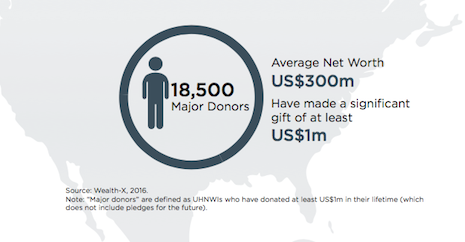
Major donors have an average net worth of $300 million. Infographic courtesy of Wealth-X
While the charities supported by UHNW individuals vary, Wealth-X and Arton Capital found that educational-related organizations and causes accounted for the greatest number of gifts made by affluent philanthropists, with the average gift size being $4.1 million for education and $11.8 million for higher education.
This is representative of the importance that affluents place on education, often giving back to their alma maters.
Among UHNW donors, religious organizations, human services and the environment receive the least in charitable gifts at $1.4 million, $1.6 million and $2.9 million, respectively.
Government and society causes receive slightly more, on average, with $3.6 million and $3.4 million being donated. Health-related charities on average receive donations of $7 million from UHNW donors (see story).
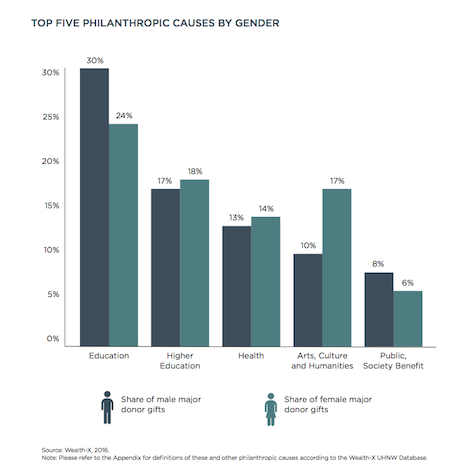
Philanthropic tendencies vary by gender. Infographic courtesy of Wealth-X
For brands, understanding which types of charities attract UHNW individuals may help in curating philanthropic programs and initiatives that target affluent donors.
Also, branded philanthropic efforts can work to enhance a brand’s reputation, give meaning to luxury products, spur long-term brand loyalty and give marketers added benefits outside traditional campaigns (see story).
"Nearly 90 percent of UHNW individuals are at least partially self-made, and therefore most of this demographic is entrepreneurial in spirit," said Maya Imberg, director of custom research at Wealth-X, London. "This entrepreneurial spirit, combined with a track record for success, often extends to their sense of philanthropy and fuels the concept that they are capable of making a positive impact on the world’s most pressing problems.
"The way in which this demographic is giving is also changing," she said. "From our recent report, 'Changing Philanthropy: Trend shifts in ultra-wealthy giving,' we note that a new fleet of innovative, hybrid financial vehicles, part charity, part business, is emerging to broaden and deepen philanthropy.
"This opens up opportunities for UHNW individuals to make an impact beyond the traditional realm of foundations and grant applications."
Marketing for what matters
According to Bain, philanthropic initiatives are based on matters of the planet, heart and humanity.
In a consumer climate that demands transparency and eco-friendly business practices, luxury brands are among the companies working to actively protect the planet through corporate social responsibility (CSR). Many efforts put forth by luxury brands work to raise awareness for the environment, oceans and wildlife.
For example, U.S. jeweler Tiffany & Co. is raising awareness for ivory poaching through its #KnotOnMyPlanet campaign.
Tiffany’s campaign will raise money for the Elephant Crisis Fund, with 100 percent of proceeds going to the organization, through the sale of limited-edition elephant-shaped jewelry found within the #TiffanySaveTheWild collection (see story).

The #TiffanySaveTheWild line was sold on Net-A-Porter. Image credit: Tiffany & Co.
On a localized scale, luxury brands have also responded to the effects of global climate change in their own backyards.
LVMH-owned Scottish distiller Glenmorangie, for instance, has launched a two-fold project to clean the wastewater produced during the whisky-making process.
Glenmorangie’s projects will work to purify and clean the waters near the whisky brand’s distillery on the Scottish coast by reintroducing native oysters and through the opening of an anaerobic digestion plant, which will culminate to protect the coastline (see story).

Oysters will be reintroduced to the Dornoch Firth estuary in Scotland. Image credit: Glenmorangie
Efforts related to the environment often lead to compassionate fundraisers when environmental disasters occur.
Following 2016’s devastating 6.2 magnitude earthquake in Central Italy, automaker Ferrari, for example, auctioned a one-of-a-kind LaFerrari specifically to raise money for those impacted (see story).
Similarly, Swiss jeweler Chopard works with the Happy Hearts Fund to rebuild schools and aid children that have been affected by natural disasters through sales of the Happy Diamonds Icons bracelet.
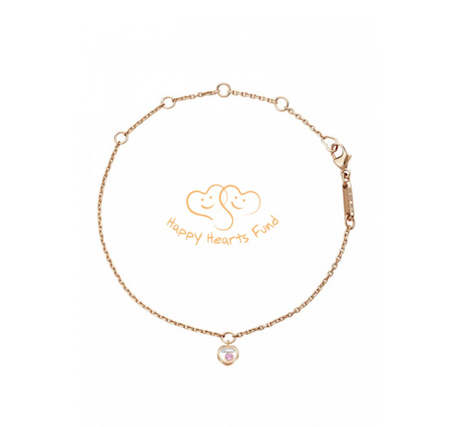
Chopard's $1,540 Happy Diamonds Icons bracelet is made of 18-karat gold and has a pink sapphire pendant. Image credit: Chopard
The Happy Hearts Fund was founded in 2005 by model Petra Nemcova after she was injured during the 2004 tsunami that devastated parts of Southeast Asia (see story).
Helping hearts
Helping individuals in need via nonprofits that work to combat hunger, poverty and provide underprivileged children with education and resources are most commonly supported by luxury brands.
Investing in nonprofits that help those less fortunate can imbue a sense of benevolence and empathy for the participating brand and consumer donor. Furthermore, by launching annual campaigns, brands instill authenticity while boosting awareness and support for a specific cause.
Each year, U.S. fashion label Michael Kors, for example, launches its Watch Hunger Stop campaign for the United Nation’s World Food Program. Watch Hunger Stop activates consumers through purchases and social media participation, which is then translated to a specific number of meals donated to the program by the Michael Kors brand.
In 2016, Michael Kors pledged 25 meals for each Snapchat photo taken that included its Watch Hunger Stop geolocation filter (see story).

Michael Kors' 2016 Watch Hunger Stop effort included a Snapchat element. Image credit: Michael Kors
Assisting those less fortunate is tenfold when the charity’s recipient is a child, with efforts including one-off doll and toy auctions and community outreach programs.
Luxury often rallies behind charity initiatives that advance a child’s potential through education that may otherwise be unavailable.
Over its 10-year partnership with charity organization UNICEF, Italian fashion house Gucci, for example, has helped more than 7.5 million children in Asia and sub-Saharan Africa.
To commemorate this milestone, as well as to highlight children helped by the partnership, Gucci commissioned a short video showing the impact education can have on the lives of young girls (see story).
Gucci’s Growing Tall, a film celebrating its work with UNICEF
While access to education is paramount, other luxury brands have supported underprivileged children through community projects that play into a child’s interests.
During the 2014 FIFA World Cup, where Hublot was official timekeeper, the Swiss watchmaker enlisted the local support of Brazil’s Secretary of Human Rights to build a playground for children in the favela Jacarezhino in Rio de Janeiro (see story).
While much is being done by luxury philanthropic initiatives to better children’s lives, there is also industry-wide support of women’s issues. Efforts commonly focus on domestic and sexual violence and gender equality.
Luxury embraces women’s empowerment through related causes as a reflection of its primary consumer base. Most of luxury marketing speaks directly to women, and it is well-founded and appropriate for those brands to support all women.
In 2013, Gucci took a stance on women’s right to education, health and justice by establishing Chime for Change with then-creative director Frida Giannini, actress Salma Hayek Pinault and singer Beyoncé Knowles-Carter at its helm.
Gucci’s Chime for Change - Anniversary film: Impact
Since then, Chime for Change has been fundraising and raising awareness for its three pillars through Global Citizen events, a Twitter-based mobile application and other campaigns (see story).
Of the many women’s efforts supported by luxury houses, working to end domestic and sexual violence is often embraced because the issue transcends financial and social standing.
For example, Italian fashion house Trussardi collected the testimonies of real women to raise awareness for domestic violence in the #LovyFigthers campaign in benefit of the brand’s charity of choice, the Double Defense Onlus Foundation (see story).
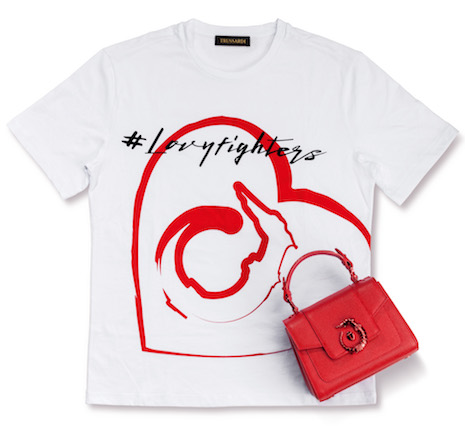
Trussardi sells a charity T-shirt to benefit the Double Defense Onlus Foundation. Image credit: Trussardi
French luxury conglomerate Kering is similarly a vocal advocate of ending violence against women, doing so through its annual White Ribbon campaign and with international partner NGOs.
Last year’s #BeHerVoice crowdfunding platform, a White Ribbon component, was supported by male ambassadors, to express that gender violence is not only a women’s issue (see story).
Similar to domestic and sexual violence, health does not discriminate by affluence.
As an equalizing factor of life, raising funds and awareness for disease prevention and research provides an opportunity for luxury charities to target a large array of consumers.
Founded in 1992, Estée Lauder’s Breast Cancer Awareness campaign and Pink Ribbon initiative, for example, is active in more than 70 countries and has raised $53 million dollars with approximately $42 million funding 166 research projects over the last 20 years (see story).
Beyond its support of numerous forms of cancers and degenerative diseases, luxury brands have long been proponents for AIDS research through charitable partnerships with The (RED) Foundation and The Foundation for AIDS Research (amfAR).
For example, LVMH-owned Moët & Chandon raised $85,000 for amfAR through an auction for its Moët Mini Vending Machine at the 2017 New York Fashion Week gala on Feb. 8.

Moët & Chandon also provides Champagne for all amfAR galas and events. Image credit: Moët & Chandon
Additional lots included artwork by Andy Warhol and Harry Winston jewelry (see story).
Shared human experience
Aside from fighting for social causes, luxury philanthropy is also firmly rooted in the community through efforts that support the humanities.
As advocates of fine art, luxury brands are known to pledge financial support to restoration projects, cultural works, exhibitions at galleries, museums and other institutions.
For instance, leather goods maker Tod’s Group pledged 25 million euros, or about $34 million, to help Italian officials fund repairs of the Roman Colosseum. The first phase of the restoration project was completed in July 2016 (see story).
Tod's for Rome's Colosseum - The restoration works
As for cultural works such as art, literature and music, Bulgari has pledged to preserve classic Italian artworks (see story), LVMH will financially assist in the publication of the “Complete Works of Voltaire,” an edition that will include unpublished texts (see story) and British department store Selfridges is working to safeguard London’s independent music scene (see story).
While many of these efforts work to preserve cultural works and landmarks for future generations, luxury spends ample time ensuring that handicrafts, a primary pillar for the industry, also survive.
For example, Christian Louboutin looked beyond its native France for a charitable collaboration focused on retaining craft.
The brand’s Mexicaba “treasure tote” bags were created in collaboration with Fundación Haciendas del Mundo Maya’s Taller Maya, which gives artisans a place to gather, helping to preserve time-honored techniques that might otherwise be lost.

Christian Louboutin's Mexicaba tote celebrates Mexican craftsmanship. Image credit: Christian Louboutin
In addition to commissioning work, 10 percent of sales of these handbags will go back to the organization, allowing it to continue its work in Mexico’s Yucatan Peninsula (see story).
Getting the word out
Events such as sponsored galas, auctions, sports matches and fashion shows have been the primary method used to spur donations from affluent clients for decades, but the rise of social media has opened luxury’s charity work beyond VIP consumers.
Brands often leverage dedicated days and months to the advantage of the causes with which they have aligned, sharing online content and participation activities daily.
For example, October is Breast Cancer Awareness Month and many brands launch efforts that tie survivor testimonies with pledging opportunities, with proceeds going to beneficiaries such as Ralph Lauren’s Pink Pony, for instance (see story).
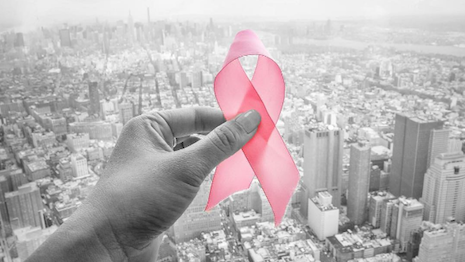
Many social efforts incorporate the breast cancer pink ribbon in October. Image credit: Bloomingdale's
Similarly for November, nicknamed “Movember” in support of men’s health, grooming brands encourage social sharing of before- and after-pictures of grown-out mustaches and beards (see story).
A similar tactic is taken for days commemorating specific causes such as International Women’s Day March 8 (see story) and World Refugee Day June 20 (see story), among many others.
These honorary days kick-start a conversation about various causes, and provide luxury brands an all-encompassing and consumer-facing platform to discuss on social media how they are supporting NGO partners.
Sharing charitable campaigns on social channels also allows brands to share philanthropic products, designed to benefit a cause, with an audience much larger than its standard base.
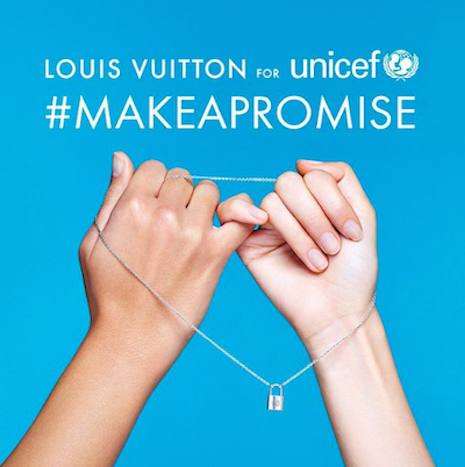
Conversations are generated using charity-specific hashtags. Image credit: Louis Vuitton
The charity tie-in of a specific purchase, such as Bulgari’s B.zero1-inspired collection to benefit Save the Children (see story) or Louis Vuitton’s Lockit jewelry for UNICEF (see story), may convert consumers who do not often shop the brand, but feel compelled to do so to help others.
"It goes to the data. Who are their customers? What are their interests and their passions?" WealthEnginge's Mr. Lukich said.
"Some time ago, WealthEngine realized that the same people who make major, transformational gifts to charity are usually the same demographic which makes luxury purchases," he said.
"So find a true fit. Don't fit a square peg in a round hole. If it feels like a stretch, it probably is. It's like putting on a really good pair of shoes. If it's a fit, it will feel completely comfortable and will be very natural."
Pledges of authenticity
Despite embracing causes across the board and publicizing ways to help, the luxury business has often done so sporadically without putting much thought into what a charity says for the greater meaning of the brand and its narrative.
If a charity effort does not authentically align with a brand's values, no matter how well-meaning, consumers will see through flimsy CSR campaigns. Consumers will tag the effort as not being for the greater good, but for the brand’s bottom line and industry humblebrags.
As with all things in luxury, if not properly vetted, an effort can come across as an overt product push, or worse, jumping on a passing trend for the sake of the organic reach provided by charity campaigns and cause marketing.
"First, it needs to be authentic and the best way to do that is to align the cause with an organization’s strategic goals," said Cliff Sloan, founder/CEO of Phil&Co., New York. "Cause marketing is not charity. The program or partnership should be conceived and strategized so that there is mutual benefit to both the cause and the private enterprise for each transaction, engagement or other performance metric.
"Second, the cause should be strategically aligned with the brand — a natural fit, extension or marriage," he said. "That will increase the likelihood of it being relevant and feeling authentic to consumers.
"For instance, a hypothetical suncare product that fights skin cancer, a food company that fights hunger, a cruise line that protects the oceans, a sporting goods chain that supports youth athletics, et cetera."
Best-practice tips:
- Cliff Sloan of Phil&Co.:
- "Engage and motivate your employees. They’re invaluable advocates and likely have powerful social followings. If they walk the walk, it’s tantamount to conveying authenticity and extremely beneficial to the program."
- "Make a commitment. Cause should have 'a seat at the table' in almost every brand’s marketing strategy. Invest the time to align with a not-for-profit (NFP) partner and to craft a proactive strategy that extends for at least a year or more. In fact, there are some nonprofit organizations that won’t accept a corporate sponsor without a minimum three-year commitment. As with most other marketing programs, cause partnerships and campaigns should evolve and optimize over time."
- "The cause strategy should be customized to the audience and 'voice' of the individual brand and promoted via the channels that are most relevant to their consumers. The usual mix might include advertising, social, email, PR, events, on-premise, if applicable, and direct marketing."
- Michael Lukich of WealthEngine:
- "A charity's best donors are often their best volunteers. Very often, high-net-worth individuals are courted to serve on a charity's board of directors where there is an expectation to not only give, but to solicit others for gifts. One tool that we often use is our Connections relationship-mapping tool which can be eye-opening in terms of who is connected to who within the community across nonprofit and business boards. Leveraging this tool can help not only nonprofits, but also luxury brands. Many luxury marketers are eager to integrate philanthropic interests into their branding in order to build appreciation for their brand."
- Wealth-X and Arton Capital's "Changing Philanthropy: Trend shifts in ultra-wealthy giving" report, 2016:
- "Millennials are having a major impact in changing the shape of philanthropy, ushering in new models that combine traditional foundations with profit-making endeavors and social enterprises. They tend to be more socially and environmentally aware and are driving employee-based philanthropy. Despite only holding a small amount of total UHNW wealth, with their less traditional models, millennials can lead the way for other UHNW individuals to follow."
{"ct":"IvVagHt6lzeElzVMc8IwhMYu5mL2wB62Ci6hP7\/uFYwciSoqPb9lfXYqy8pqVG1lmsE\/5jiTuEvGmxT8mLddcKegZfKlikJX+wal6gLWMdrpXnsH+S8vMq5dd2wF8rjYWmK1jpwc\/r9xX2dCet6K87XvFl\/w8rSHWL9L1MEN\/oXeEfd19zmPnkj7K2AJNQqi3knb+QL\/XeIJS33h1rg2859AXwbd\/erpZq\/Vt2XNootj+edIN+9g3uplnt85PcCjZlCjO1JwVoD8b6CiL8Sf8vpsgS2iH2LBkn+SDto4xOkX9nFe8ijubWcOH9rvKZ340RGUvSFk79eFAPhLUXI9MO9aH7wzmqG1+tHnBRIsqLVbbwHA0r\/hYnoGrTat9qQExG5bK4Bh16TNSj4bT5wzv4Wiop08PReEQjfBLKOUM6IFY0VDs3FjBXUZjLsgLmH+X4S9u1DEtFEdZiWI3Nbk9fiiBkf3auumKx3MHF54Y3EcuXJJrfEpgHMwY4onR7rMVkUxhIpGJdsY6YNkTBgqUvG8DFzv9sxpK34\/i+iMpuEc2NjBb8MNiEax0KCg\/VIAq1dBW5xaeabbeeJS5Xu4jYqK9gV48nwYGq7mwx9dwisBPFZVVtrbs0naKSir5r9ztsmDkdeA6gN9PhkEjpryvUNvA7147lX\/dHqnmctX++wlxQL0LTVbPE+d2qFCDgjV3+PUdlAq1PN99TEOxGDWK9uuy6j1UAGTqFT5yvQbKWAjy2j\/xgU+vYpnKmBHV40zJGVr5BcBSFkV5GnDi7nPjWrCHcx0WrPEmRk1JZusa6ECeSEWrtSdBbYel7HJnEZPFeFzLuwLPze8qR67c6i\/cm28BEeoBRfaTivPmQA56re8RLM9nDpuZ63ZcFYfWv2uKfH2oMXQUk5v0SzlHC1WikzP+JY0FgZ+Ei0J1XcHdVGaAq3HkWRLs\/Jxfnur8Qn7MA96ZoDFTsa4UE0Vm9eJfoDq\/U7Pn2plv0dXdXlmqxmpCxiKj2rVNTnBuHTyMPKomRvRGq5IbASMsZfQ9eT4U22zoFHuVhL7YvVAMAQgIUTh0TFVe6IZy4qhJJKi0DsBLJUUk55ENi8PLBcv7lCLCbBGKf09yUyIYKHVI+zIDcy4fUPuLcXYeJ+6gU1W5122ylicFSwi7Xwb2XaWqwrqKsj6TUx0\/dpn7fyB1DZDIjEqihUraez9Z2lmf8RVHPocgp0UFrI70z6zBWUE0omrUOo24mtuxJfLHM1wC7+vlXzPcBJSZvXsCveac5SEQpwEKeneZwn1Q39K6Y27euMNi8lejdKjZF8SxSVtqu7qOt2I5JENFBUPBf6rw9nOryIEZe1Fz\/CDMS7Udkh0bzPpi2E2rXhEYQf10CZ3gHMiscHuAgt8dQ+0zX3M7QucdUHJGUpfMq0V0YcJ\/c6WgAkI92LqX1bLiCg5kHQiP\/jevfxAGef4TxgukExtvlmb+Rkcg\/jLEao58b7+g7e7hpVEDtuaLbT7Vh29atby9H0wqeGEcjRMWCYh8G7vNlq9vkQpzVxrYjnLVfSlM+ImvbyAx6i5iI3qRyFPb2A2tHaTO5OzutL2gumO5JiebbzIUJwcqOI1Ewx5Ctli+zuVx9VBCGhO5Z+ScipkxSctXmRFhueH1Bp9hKjYQ+b38CFBrIeVfkrGDW4IbfaVFvC7pMPfOji9dld5iYdBhpiSHblzMeJVcG64z5RFl\/rlk76MTvGf3\/RNha4eNsas10zJml6z479VpaYY9phc5PqMzg7gYA2lEZntbIiLOFAfkIjUKBoIapOdUzO2mAccwPY\/vs+jW7+1xWI6OX7HECfn3mw8pmkmWlKh1vHnEpQ7ZGBJ7YV7MODisM7y5zR3tjKlADJQalJCSCRN8ONYTmhiWCly9YjevLD+wbxSxbBtuYgdHBavxwJfGIhzsz7d1u6QTP8EE4c1GsPf\/+CeKcZh7785eviUCasmkB1kMSo\/cyl8uEAX3niIv9yqX9XYwMIH9gWr8+tFFIqBN7c2MxmCQs2JkQmZplS7LvtLb2T3tHZaaSl1OBIR0tj1yzXfHggoEWVZGST9Xh06AOqvEL7NQJa7TZjl+glvQaC6KZjjATrmMd91CrrFy09l242rBYiZGvGOjNR2t6\/pP33goaxElRxFqy8oJGThYQbryiAO23NkcTjDzOdnxsTVfXD4HQURsKCPF6ZzJc\/MUUKZuA5SdFbFFTmVTyIMYFbqaEI8Szywuj50Tlxvh8XurylfMiIVpIZUkRc4WQfds+KEfV8WDfEhvqtA96mZwoFBCxFA\/VHxiEGFJOCNME9TMO28ocLePYz5XBdBblXsHELw7nYj30PxP65iA36KanBfyn4iULk\/GwqhIdueaSURO\/lhQhlKR4Fz6Y9jOvzpxlVoat4X1kWmx9yfBqpadzhDUotkFnm6ecvsdv78lhfLlLQ72p2xp\/bRQFHm2Jx1XtXpGC8deo\/28X6+MPEuleeB9umV+u4fARvXv8OA38ASRd8J7tTjUzYGun1whJNHrH6HGdv\/ig6D1VeqHRxWFyf+Ntm6OjdahIeO50Bft4iuJi0E7cl6qkKYexC8U82pMIvK9dJiP+68Geh0F4D\/5EBdozcN6xhIsGUrtI3cHlRC+aFbYEBawyluR7ezleYqyMC9Q+v1VsLyaXAzt8BDtutWjdZ6clM\/BIYljXUHaxAjiROFCyJSWEyfACwaVqLaWAwo4pq8Q8e3fx6SR0Z1ymVy07K0HK0pYoUfrJY0MDspN2ctxsdIokBFQA6aGgbFRMC61YBTfXyqf4MzvYXImD+NCzpMShshyR2b7J5dlZBKukbJguzxt3Tg0uzJOV33\/EnYk+pxGjb1jrz636+GaR4XaE8XU56rog6HBychllU1ExB2d8Zd9eonkpRlc8v3BkbTUFzm4aErVHltm\/2ZTTbQ0waBxCreTGJZobOfrBq2lI5e5yfAbrAoXMHhgXUoIzHV4hpNNRtBo1Lz3Z32ghenxleCvSPvL2C\/mbkomih0DpsOhInxrpKwgMSal6c\/6i40OF1j87i78E882SB9qt\/Eacu9CXfYtIMfALBxR3QHKdNK8LPJOV8YtMKd4nj9d4YJdhG+d6\/4e6bxxiVvvgb1B+rvY8OYR0ia0hKtTDDVznnfLn1tZKs\/sRnf2AngZe7XS4ObTXiBsUVbcXicrhiKG3c2VDFA5GuO3KjzHkKTmXnT\/43HHx2U1NBjOi4c6MAd6SxJ6fr7IMrkE18X\/JzS6N584vEoKwBWrA8bzTdlYBPtO5kdCmFsCAp0fHoGePf7cVWPEG\/dqOgm9ETY36HpLyN8fjIRNVgWQxVrrIRA0w5HP9SDXp878S8KFSmhO58syGuRURmtMsv\/BChokpGwwBSn7\/GPOJ7KMQr8jQb5xPjBMkXHmTUV2dzxbXiA\/QjHbGXGTX3WvR2AefKjU3pN3O1vKWAC4z9e6BE+CL98cS3ogFI0njwoYBhVz2X3SvbrWNbSLViLSn4BdOvfMq72m78kxU\/LXL0\/xaPe7jq7+jKQ4lwcOGJ7R7yr7y++2+837PQ7e8hTMfsQ\/2rq3cNoHDuqmFOsB9NJeuPaO7mfueBQ1g3XK6sqtzzQoJfHNQI\/0ZSNy3JhDMlsvqU3t8ADFROA3Af1bk1HNhqvL47L\/KGK1\/fnh3\/lrhU+HT8cbcYmWNe\/TlpnrPrC46C2bPvj8BS9rcGFRSs54Bxo+Kxycf7c5\/HHVj\/Q0jaZ49sgjpHa89mTTVG5+HK5MRWq61ZhtUdVdqMAdOtgFGKIllgFY6WK9kNaBfguqnkmdECrnhQoSTO\/GnQIrPbBKcJc2Vp+L1KJp9Row0LQz\/JXsbasqGkpuAjDwF\/4KbMo7PYryO8IxJZs+0wbELQMZXhWFHoa2zGHUO8tNQh+iUD\/H26p1ZxnAk4I5V9Cbb2D2T+JCGatWKTGd6rux2dKCQb+FT5sQJlIOiWZPYJpykDVIGSIpPsUaxpy9ewJKi5Kb+PrEMrUuqiwjdBA9XI+eRiT6ZtCyB0OB2g4VEVYDqbYuY3Vpcj5ns2OOyjj1ykxIqhTifvwbXhV1JWZmHXIWIRT3WOVWOkKyM7gz4BTmYgO0bMtkX2L4fHe4qa5dR760FG3e9LJ1hkNFUlFaXQqOPjL+8fwaj9L7FlrRy1PcV761jJLy2cIcZGwHE6Kr0Mbbv99vfRkfkLlJ1kLWuNFtkzqXwdB3v9yZeMwQueRYbj8tHpy8PVMkyGcccL7ZHGYNnbwBQRMpBUZVRb89Vyk8ndXzCTPqbM4n6BySkUyIpJchV05CPhhrsziSCsgzPhqLFgnuLjlL84aPGDTjIjpfsVrfejsrmF3dilzMuvPJLN45+Me7M7+cnATkn\/Ak6TAda\/km5QHCai45S\/ccCAYSiqt59v43NcUuoVu2xFZRUkafW4uTSmCaANabvO2tfD8ybMbya\/YMrfmgjAcas7ZBuB05ILg8Y3Jvmkl6A0SkDqcp\/inhkW9kR3f4xwP\/YDJKPUO31c5u1mUBRfo46Mw4x4nHz15ixkUFzPtR0zrL4b5VxXYpOQDvVTZ2MGsFRgguAcgAYua5qCrPno+ZNDCeCraDzDSkrxhYUSDHv6lEtW77Iei4ExBFcngDjlv964bUDiYqaK4EinOiY2UB6SC0LloA4nE\/Rec7gBfXaKNye+dwcJ9F8iLo7Cf\/L6WMyAlp90eUqXK2kw1BGoK7DYJiRxK2hLvFO9WKYKRpx+04xkS4xv0okmDE6RYAYo2g52NvqvpHszqvIHEn10eRUDqtRWQHSplav8MTJMOiIV7cuVDq9WK4f895kULpjAVC8RCHF7fJtxzD0sTK4PfMohcl\/ZNE+irR9ToqfqCxzazkEVKC1vNFX2zfugyAk4t\/CUJ4tJAIWtqCCc5zjvqgH9aszaPc3\/aNLHEV\/jRaOEze4CoBHBZeyQZWTvlZIRSCyyC+y9AqUGKAcijQyqzKQkTZIHR\/9fXaSVDdaRVwxSP0\/w\/eNq4T6gSMkwHTMnUgOzdGipK7Wi+jrvpoWVm+77JEJRPuYp4ZuEAhLu41\/+yTlSAXL0Uuws7UukJ+zuc\/gyp3Zdwt8kK8rxvbqlM1ajvhUIRTnEzadyEM1Q+1gAOkPtkac1yDzSh3T7m5zacKp0G9RZkBRflejYjce21qDD969Uf1cEO3yG9rt9J6M+N589iNSqUgRlrsS0+QMbJ2lEzHxysLePpPdj45Ac6czvRjKJGm\/G0D2rfBV2TKHvBQ9LstGGSD5SkD4fU98SCtqfxIwoiGgqZ2bvJOrlr2ynOsu6s+0i8Ga5WpnGFuGj\/3xYmJzIksCTIdxY58smP1Tjt9jNaNli+yjPyY\/h+ET9lQSDZM+\/f6KxN2TwjMXea9U3pPxEx6uhdYFfrtjM7x7XlwJLs2waUL1Pd3NZLAo+oIgeb11xZUdbRsec8ze9zXufvoc66iSSSxerekyY383dykzBvToSyeB9+7b4NOODSNhcZk69YZqAUSM01skuyCiXcLOjxIK\/NZ3083K8nxSSvXy\/TMLMySWPUR5x3Ubunk6qVdQa3J7kNpDdoaZIQUznMbM6CCS5nTdWT+BzegttwguTCOc4Fe2mR49O5ZHmJPmu389Sf\/ial4xbNxz57o2eGEMu02xPZxuaQHVVDjntUHrQ2KpPCu+ZcO7lvYhXMyRBP47IAUswK5dlsLhW2T0Dzj2+RtAR0PnTtQuHK71Y1EvyvBFa8pio7AA0zxnsAeS1J2EnIJYEqdE00GWwjnXn+uKOS\/DK8VzM8TjgNc3ndbxgxdvanSr1OMf6TSFWHXKhqsJ6+ufpqisYwY26SCzad6Wm34KCAei99XBNNc+uSSYrcOwskr3YoCCcny1HeDEarZ8CB6xCEkSywL4SbL8CbthpwuJjQYGLxFWiMVzQlUxV7xOmPRHuvLgkMckzNWjNAks90xy6OLXHlaluidugjWJd0J4CDPKxW7g2FrcQMpvKLcttQ4n2n+WuekNfLcwUvytptVCdtrzHxJrqiahKtBEfsT7HdMcuIlh3j3DqB6K90\/z\/IdhATZb2zeO2wF1l8SNMwGGz5icVHMlCt04sTJiIvLNJEDcdgPPk2CV8q6DHcO717QqJXfviI9qy1v5hKAvcSqiSP8Zl3HxVgOeDYbxO87wQ9tW+lHL23S1PxBDNyn00lWnhMZAbgXHUFe6YLVlgY1gVss285OiU2zaWtoXuPC2VK6PvaR4lFLtuyumb9Ckw1VYqRHL8QbI2kVC\/tNg553s0DjcC875ryPZxIwuQmKTv80Zj8Z0t2beULVjp9mc7FQhiDa23MHt+WDrX3BTZTc0n7uzf4RGZqOMT4GE5A+3nn+9EutO90sx3CcIDSXNUfmCl2l+xZPa6wBuy5AwRVS2t1v6q4VIio5mekHATC08gVeXOQX7CUniup1Qwfry5S2YYLJjeKWcSU0BFEm+ohrQ\/5LdCMaRKMarhiRfBtLgJoULdrUyZqqaWwTsJB8m7uyp+OcGiEwEjYUYY8FXjcUS27jbZb5YNW8xUqwRIAVxyLdJGShFCZEeSYCCzEnhRNTcXQzJ1lJSlXkEA1O\/pwJX0q7g3LqmTD6+cJEv5aJ6I0d0wOmgat4Ud\/p2gnIkongDj+WJQ3GQF+2Pbsh+cQ8c6JT3gorhVjHie4YXL6aQJ5ze+J6\/xIoVjO05CjDVelQuV7UVCNeyP9nhIZqdgt0EtY5rPvKwwnKpX49v2zg7Ttvq9zIHw3kQvfTYFmXSKLoJl7FWNbdyaJ2uBxyqRtS33c2xw7q2mM6liNR2xmrtwiQqGU9fZxLyUb\/P1beJFnagJskCR\/qL6nAgilfcs9dGE2qO6H0IXAmyw56pV9PGsfoJTGYCFwsJC\/b2iHdEByGEG3ZlwKaYFFcgFXyWIvum25xn17Bv2T9cWrypP5Cs\/5ZbE\/o69J\/IxjTtBsls6UaYlUXHCEazcxyNScEjJ+3s+60LjnVcpG8gYPUHB9V\/7UAez13oGK8bW78mSt5Md8zPy\/dCZ61u8xSnRgULgtjYcK624tB5xs2eyVx1pC12K5\/2UEw9Ng\/8PVcHLuZEqWRd40A9lRZz\/rNbiuV88Ck\/tDF62GRbFAjsaXPMSsVxg+lZr2MBIjIfohBd7y0BqCXquWujQ\/seOlvhf0Uah2h\/+aDVB67joERnNwYYdZyGOfAxfrG+J7kUTGIzSPWyElW9Q8X0OMeWq+2Ha\/hnEaqn4wG8V40y7NNG44f\/eCYah9Wy08eCCf2AfrgHVUwEyQtyKsGVni6ygR6iAlOajeCPs05M6VFyFT2ZQW1RUfp79CeP1Ck4FTs611NGgfj2QUmLi7D9ef\/YWjSpItAPicFSBF3N+vX5Xr6uEiZ3FvEo2UB9\/+usvTjUwzSUANiaZfv38ZCj\/1+hBKKz6L89KP9EUiRmf9pqpmol1yYmJ4ojWn9szjwfVQS0LIXyT6I\/nbIYE\/gMD2Jf3Btpy7Ot8mkcWE0chH1PSigE1Vm\/2PH6JrNBaRRMRW5HuLW+zMs\/yQu0Mm2CQJ89OHTBJ5yswhfmLck7zGBAd5BtD9vo9e6ykB4hWOKqnAw0FFQpvsJG5NKtVaAqYRL\/FIEtFOrWFbR+bsFD4c5ehR2La9LxgQ2HuTfn6SdMp9Vj2MRF35m7K2HBrSfNirMdTQ4jI87KBKUXBhfVUw+L8lkCMrRkyQyN6EFopX7ttyRjzMatXosoJWTX5ddomL2CMawA9anuB1hvMB1qRn6csZodRbcXbhDcB9k4Sl1haiNLYEHgtsX5kTzHDEwR9QzTmxe0JIiQ5MknsBFhqgcPNDSNzGdG6AeWnVRNHz4UeDlIWXQv61qDmg7GNq48QahfSsKWIE33dSbb6WOSeWU9r7uYTP46ysjiToifkEHuGrWaRYNCJuKp9mGLiZaVHrUOxBQ\/60I3CuPTSIsf9nVS34YQI2LNAxCvHV6cW7sPPtSDfS4Py3r87QD2fvKt+G137pfufQ0d6mR\/2jGIklzifilm8L5YKVkJpr2bcSluvLXWwDVFHUBfoF6aRY2dxGdsHr0TDNYwOPxma03TffOlj0q89iYxQ3A+CPrgCnBQZ9v0Ji7m6Qug\/iMdIJDuCsUOGOM3Gk1PM8mwvRJK3\/biToof39Mtt+tQuRWqM4MYs8ksV76wz3hs5NI39AGtuP117hFSMmy4sCmdwo+NsytDg036SgRvfsebEnJ0TcxU2WSA0hpqFomBwtgsLPsAbqmBVwqDKcjaZi47MrMfUpZCjurJB5rejzb92NYP+WEohLJOIPQ2qan+rhBTptcnPJ6Nc+Je26f+N501mug6XyaOcnR\/KGFRDl5E38PVqHPwHjc4ue+o6l3EtuQRyT0NtJgTo0yaBwzKHJ8SjTR54BiurENDvSpCxlTHAlmfvT32N7ikiH+kc1Ia9RSyxl13TbsU\/461FZqPcrlOILpvjEqq8wlrKhOSSB5OZUgxN1qm\/ljqxA4qNN9H7SyfRXVP74YroXbz7w0CUhu20JSKA5D+TnB6TVyhWvN9BNqRHnM8omVh+jWkWEPSy\/ICj717uLZrl3CPq1eqYzvJcg16PJcyaUIOrbHDpadz8Vxo7JbvZ6TFQgRsC3L57M6CUAT6JNcukLJbdN8u6RGES9r9ae3Of98g6n1zIhI51JqToYCzCz3E0kvlFYqa5p9V\/MWKGLploBxOGCVJwtwuF2hFs5k+LGwV9vjsSKKXDqHF6HkDkxvvFWmQwxoD9Wz+Hk6QAU\/tWj7v9rQIVGopnzANM\/zv2Ppn6Pa1oKuwSsMlQ5sNV4d5voh19Ypg2ITje17dMaPIWeCVrkCQQ2Gso8Q9V0yla7g4fsu1IwySSj6ffZmZARxFH75GmouZZt3jzhObUZpnHLq\/NoxgZLEaVGCrvmmqmIHMGgSDEniNy7js8ANTp5X+fnywWt0Ch3OzAFjkqhhmAEaAzRthgEvL\/+w5MUWK\/DyiSCVv42syP5XiLFFV6gT6wtwXdUnnS\/0giAdkDstGO0pCDxxcwGVR4XrRSmazAi\/NAMRtNl6QgDGPBW81jWKBIXcxkxQSdX8JwTi0EFv1uyM4eNr45KQkKBlKVe2poI2hT+AjtwTT7lHuAshlIwCg8zLZgfPDNlgqx82mu0Sptm6aqYkixEQQHxrJJMKmkTUUrkz0V3Gk+fpgJHcIh58hbPT0tnB83N68yKxgpxN7I3b\/eqKnqpatgKi8wBiS9TlkYyTdva5ixgBG8ZZDNjp\/3DG19tzO4JQm3OrZEq7f9Ljbq8uBO8XgDuUDrzzWHzhbjkVV4Tg+CLpeOtKNTDewA\/2J1JbwNaAk4M96GcBtOsxh4vNgLyQbMeOINKslFbVNzUUA6g5vVJMwJAWDclxFB+5Sjx3kSrzJOsEw3bPym+srHAzdYUqZo0X4X7FSJlsV4AnpuwxubMWyswNi5oK7r6fCgyvBHtOUb1DT2kMSt0oVK6pdOoqtEbhiNeW0oseQGzml7X9EdVBLefDVxHvqNKBAewdex97g7Ael6Yt7ccCMX+j7G9xZWrTwtMVb8tf6XnDAa\/rP\/CxEdes5OzimrxqNXOQQrQ9i9mdz2ytyy6awfj5yXYgegQYn5DnBVlbkODJOYw5XQY6GYVo+p\/YGPvuweFpz1BeaJWSP0SPN5CMvDLKCh55P2sjn0FXCvhk1ye0OuYajOvq4UpIN6f6OX3tbHJC95D07Brl0h8tpRyBNrRtCN4G9vFbICLZskfcyb2Sa6TODl4lLZanhBDLWEhUW\/uQZkT9bZuiAtmhv2cJLmNyLFJBzMcklL6RxH3Cj5tk3j33DuCjJeLPE4uCacPLvPR+DNCgk83S9IPvOwte8N+8xmeCQLy17rhn91v051L7L08vtUqdly3\/QMjX7qyDSYHPekzcrr6cAp4At94sNK1Z\/7PuGfvDsAPYHFmmAMDJg25XpKzJKbo2Y05L7s7qZ4x0YzJF0TMC9yAuv5ewCdMAQEujCrQIuGEoLnLY+UbKpvGY7WeYjrp5RCPqZaisGb5+WwwDffnPqn+eyZHgUfIfPHV1Zxmpxtveko7hN+giAcuGjpIMOuI954frZoDhk+ZiM7sIoi8GSVRQRdRzxY9PB92+8Y1bDmaSdnA2z+CUT8r7gjgazRnbce0m2bcvyBAblnnLf7OVkvS3\/D8jQ3LTp4ndaLTjmB4JJ2rBMXIjErCCfcObW5YQgWlNohQMpFn9L4DySw6zUINSH6HTZvhSQlD7g57wIljEIer6iSwhZxdU1wavB8AYTh4afalX42e0o1Y3nVtuwwu3b6YtDreEc\/CdXAdQ6LgiZI\/PmntvgTPHDaqPPOdUkt0UpLlrXL6jYTsPAMCC5AQwU\/iH3WoDyGCFAaYGpu2QO5rlI2OE1avia0u8vM7FTLZOnlErxyB7pGrEZkvIFTcB9P\/uS+WaCcxFwVjK\/QkJUNmSD8zH5RLcZu7qzgGAlE2tSS6Tw\/td32xelZ3u8gLiGTzFxkGJg\/CcHL8vmU10x8\/dsDnYDYJfAi0KOIB5E8vzYo6XMYZBta6mL6xLwvUETQWV4glpMltaFcwItfqeeRQE\/k6OXmch8H7nWOu8c0lDvlIgLkM6w7Wv4SZ\/\/cequTwFvJLSsMdNyUvJxmomyuPrvz8jCQQq2jnUyxYKDqiEP82ZW47LefRZRGDj0i3pdXwwQXCpS37KQi5XsRt0ACUdGiS4ut1pGExQiqEwsnATw7nrzLaWYq6j5g2i3UhouoXLpstGsa6wQTKgrRizF1puPC7IJNvmeGa3PN2h2ddg52o4mU9TryoN8nuYmXq2YwnWe42WPHfZzAg66cgY8k4TsKS9wEnr824TbNWsXCoJ42n0tQUjTtaxvxal3Wt8hzZiKNPdmUi2CDP5plOcICkuNxl8lQNLA6iCLnlx9E2jFJpFIDGeTW4I0KCAv6Yrx+vVSfLfGGLm3dgMLbETlcfm7NfqGH+dj2m9Je8pXY6OrTB9m1dae5dcAiYFzkFVNcNdTWropW+8ZwsjPaDQu4baf7LF0n42fLsOHMBZpBS0oh06sPRh7Mfv6Kj979tJTYqppFnXF\/MOiRWSqrpYbc4Apb0Qhkr3RHk+sbFZx9D3Hf+jEm7Zdcv61ahExUVWFASbbhZvejjnukBX\/wiGgPYJ61RqWSVQEZuEqJJCpOFFDzZ0WHkh9m1mtIoSk38GT\/mD81c72+h5gVCUaUrvH7lSSOjLY8VUdDmQ1SOtbZNvoB+Vb6ALv9DZX1fD9X4F1RZltgH4E1PsDuhd7UPcrjwLx8yQW9j4J8hHpR2d+1Gxklz84BuykDhLdnQ9Mtk\/zo2LlEyC5m9MfUpYsF3m\/3WcQmzieVUT10bZDR5lAI8wAO8N\/fXcJqQd\/8ZtD\/E8WfABKamJr\/OD39U\/o5C9lcSeQ8baLy2ssLSYz7xoGU6MeYxnJi1MBjyUpBtssf3LBHK5r5HX7b0+sPe3wCB7Bt51rT51LvgWeTNo5dCR9XVpZOrfpJv4\/cKoardK7QhCEwESPOBReBBkmf1iDm5mFXXqGlo5hTDBFpfuXFZtpxOcA0r70LsD64ddH9k7DJH5uNwr5DBif3MgX2GI+KSvw3tY2AZWKxMpmF+iMLchfiKl6n8cmLaTG6tig6tlMHrBMzKvD8ssmQrOVgIvyeJ8BdQWq8Iq453IoFz\/HWV13ZwkYWkFL\/55a0zsEBB35ZT\/w3PqecbjLxv0DLxiZVh7N\/HuJ7yblfUElS1p63lz4cZ+yO5GUBtKt\/X3W\/Sa3zDNyVpB3w6b35lzFodVPuXXlLvMXP8rbpGMAdwBVJBaEKjFSPSKgaMs3K+WEdZmYWR\/YNhT3CKTeADWXhTdB3hTHQXXIyGcZvn5WcPY13TVTp1+mLbzeqwcLvyHveaTI7ehMMbea70+HrVWCI0CRbM\/eRcD7\/N36JqHEkwmY0Rbc9gRogc+Uv6PYTcz+rIkyqobZiGYl6PmafVnZWohQN0kgtKIG1i2NXTkC+XzK9u\/AIy+JiWQhCSc7MIxR7ETox0JJxuRyEQJ3QfHN\/Gjvek4NESLd4v6eggBm5BqvYqmk5TpPMAJIs4I++Ee37Yljfq+CmXWugq8hvgNjJ9FMwdGbjVWJ6WAvLedzKnqy\/WBPHymit8+Ntv7GoLcJre06D7iA6WxgFN\/IqlVmrfgGj+pY4PtEHG\/yvOI7wzOeLV2dq7FGX1XjAXlUh1uFy2tjSmWwkijcVPnZNM3nGPebl99QPnyCl0isT\/BfyIbN+Nqgx2wGn7RlrK790TWR5yJ2GSDUrNTL9qO4c0wFM\/egVdnrKsLEk2XLcGmQriSqFLIWMC2SwDJjgQW5ExY9tgYZA8NLnGAWQ2vs252E6jogTbVOhJlRwtjBQ1Zefm+rMsIOH5gh9\/GFksGxhWQiIH+UuUHoWUXp0yKeyPLZphkJR\/ggM7C10AhVHE22wP4B6B\/mgnNpsYUwl6F4PNeXyXZGn02kDE9Xs8YZ5Jke00G+dXqmARLMa64Frikq7rxNqrD3NVh4Y866MWXrbMiOS4IuYa\/xPM1yU03Lfl6Xx0LpT3G4wLdY8G7\/\/n64KJCac0sVb6IfY2CdZ2TquPOunFBl1pme2oXabzHmrCYBKOnaWKQk21xShxXw7wyWS252v1K7ySrQGKFkBLaUpk6Z0EzdkSZdouwgmIHHxELgn+Z16ffU\/eLYsEK2C21jnpnS7i51YFZEmvZZPwJJ28gG9w7yiUsmP2Wzm+8v5in0bCYt5b7L0BRqXdbBkFjAnQ0HC3mfpVE\/Av\/A3WGYzaeXJSRlKlustJDa70lVdZ3Xlv1Wh0zLvutB5WSgnUejxDTktE1a7k26AYVhn00x7Ve93ixblvkLaITn6d94B+afibkSaqLPo4OVTU\/8GkY99AdFC56xOEob1s50Zu1TS5qVVCBxL3q5Xo65kNIJ9tw4tTqr7F4f3McUZBDxe7nXvgOOrlCzka0f8vQaVFXS\/pgsceGKyYnYfk5l0MQ72m6vbcWx8ajwqIVSL+CsM0W0h\/kcjKE8YyfzFvEj6rlyshfVWKDY0BQNk5k0SDbnCythJ76zGpgubgdVI8m+6xhMuAli\/JbGa8z5UboDYKdE\/mxMkaYqunuNlMZVn\/TkR\/k1zsS7eIR801XJ3NP4sPIsYZbELnoKFPUAOXqP0AuNlK+bB0ygQWQgIjae0\/wUGq8xrhfYCJuOmfV0R5hgm5h76PX2R2mv0pkgN\/TS7l2ac9yLAVnPHEMF5QYXZ1BkEc+b3nU79rXlvE5qjF+CpHph9rxxsgD7LsVKt\/8vpGdqvctXTZJVgeW1DY0n0+5urlcA9kaZoh3Sjm2L1kh85\/gh5SEns0NqsiNQOV9vVOREvDw5oQx3hipT5Ns3HtiNdF1x8Qpo8CFn1IIpgSxKrtX5t3XE9kuWC9XgL+NLEwt8uKjJKHoTkbragiZKIiTf6ovSJZXhYDK3vzf3k4ER\/lZEHvdzbtvQbceSArJCG2kIy2p0l7LAIqRYyssQWj\/NQ90O3f\/4FYw9i2mDpEWe+qYGkLVRRohKKeYayYXzZMxvRbIARjrabAXZiUCJQT1qyhrWQmlXrRxIsb5f9Nj6z446tZSQ2L7jVpqs+E+MADoMySdLEtxPz8Od3\/4LaBVgNhwbGeNlMFX5qsCb9Hih7cnC2s88fPRX9uE9JJEqU1wxSZ6jN3GK8g8xKaBbrHtHl6TUMyT5qTypupHqy6QGIsEWgmsDQlthVnacX0z0O1PaBmpmZ6A3XUIKLCB\/Oj+8eCGIJJb3DQziLceIIOpJdZi+NKl8KWnFtqTqWohrvcuHf1xkqHgpQcCmZRozHHCW9OARKOs7JVLFoJaDvGIBpLi90ffFTe+yTuK4mL0q0TOfbMyhElxkAvAS0u\/nEQaH8fkMz8DNSzxSqY0RkRxft5OXh\/O03qzSso75gb29iLdU5azXtJvh4\/xQZeljcQ9NMAKm0yCjVHEo75nJu4QdUMTOqbGm\/s69Mog+bW24UTHRNVM0iFNf4O+Qchsrc4Isk29MReDhr2LLzci4d1qQ1XZbjVrpba93J5Ylt3mOGZw45QBn3VWj5EfhpBaMoGqxZdLdZso3EuWPaxCvbPqjNA5e8EJTK3bMRgat1jccaxlg6kuOBPm3GEGHDS8YRctAlLA4b9bcYnGb054qtzDxM5SiviEiM\/GhvmkLiww4EhNozduilKuBbuHs92J7jCbPdWqziPdCS5b9pAqQE\/3aVrLirwc6QH6QIOTiu+Es7iG+J\/CojP5vxKcPh1PiE5QFXWZSrz95FS8ly+wlDWXlx4FjJSEDiQLk\/ODS\/tqXYq6NqJMncnY3XAmZnW2Zt00joVIbPv349XQLROUm7MnMyDYhwLKXAa8R4T4feX8wmJ0ZkCjjnF6A2evBh6jO3OyE8Aj3fZCOYAx3Gz2vNNTgk09fsi3kW+xWDXK4XocEAF+goWal2hCS2Y\/nQTkY0RqG0d1YPe+g\/YwDQ8lJNbp0537d2coIqoAGkVEv0pT2jvr6JtX5\/XIe3sVkqSXC7FRMuuv6XwKkjyEgu2cf5ADHB6Iz\/eHBvSKJxpZR4QkuotEKcfdMPg7QpRFKLgoya13RvQ\/276KfFKhFv5pAc5xCTvM9FUPYeAjIfrDUsdI9QtZti4uoWr9TXrcM+cTneq8oTYOuSGLTIyy6\/+dCKfRUxcyhySM+FHTDd0cBqJu6a3CJfAOMxO8jLNrG\/pzKJVvB0uI1zl6UevsilnjMEBa8VLrcBLgIHI5G3m+IRAdbDwJ+IvuYcZv6o77znLNDorYTRW++NdBn5GhBdm20sBpOwN1GwU7vTB0EjrkySwcni\/qpgpIHwXnHnfSzh\/j8daQUv8Ez\/mtf4EyVbLH9dhojBjXKiXG3mRhY\/NlNWIxYkzQoTYBS48y07GeKsxn0lIqev4oqEmK\/Cx6757eTqqMfP02cNjSaIHYNURip2Mjq0ihWbzLYalhmEDVVq9CjAk2aKHN4a7hC2RDu6y8wikRvm04NX2wTSCk\/rrJsxHyL0kRrNo\/spdvVvUrcoiBPAOga3iGIBNko\/acUltqEfLeIDSf1\/F6Gpf7beL4JxDo\/+sG8Y5lxYPwPO8eA66sVJqhcRFraF0dfkSsRff0e8vmDTbG2UIokH6mf\/jpkiC+IRSGRvoIpxeHr+dSApFLdzm16tfzUSKdkur5zDjPk\/4J5rF2jgpV42xZR6+tcZ8DpI1KdvIHyFWc\/JAoQb81KN0bTuLo1TrZ0WivnOGKwK\/eH9ivc\/2+gtck3Pl258ARRqcUeIuXINMkpLqpvy+GVnJqNTbK71l1yU1ERYaU74rPOmZL0JxFxm2dOdCkt\/6+790UDs18Rknc1UBIa8IT2W\/yt\/Z8nA8Es4bGL3h6jQuZzYXlgfUmznnKiUbBRxiRmsc5VBAoe7BWDtjaXZagrj3pQlbR39qZwu2EcD3QgO3D+fW+5BGtto5A5ibdoxoFrkBF+Vp0uu1T9MYIKXvtfQlKa6dK\/jt\/ndQdXK+CWdPe2zb5\/pi8rWTy\/qeiRnlsjvS1m3+ZYpVnxjtYlH09AL64tZxod329Zp6CCfpm6uE0WWqaaFQrwOWMr\/NFrVP+O61\/IlkVwQk7EsUqL2dLS2vtZg8Jz0Pb869GAVz81vZx8uY49h6Yk\/YjhCHKbVoXKtJzfP+FhpVflled61tetoyd9ufubqhEN78Lsx1Ic4kB6SRSqh4Geh7PIHiVBCiIFct7Q3wUdw7nM5klF\/ACuSW2vUIrcqj4b\/HnCNTLEqeUk5JiaWBlsYK4OHgGoJ\/fTi6YaNg1rOtqkjvZtROR7X+cpxp\/icyljbpXZurpXjYTzjFw3sr8xAsKx44VSnylt\/KhJKeH3ZPRzZsUiX5HKSKEcj7La+675pYWSnXCgPjCi8wsiXsk4kRT664mHEELnwtB\/e+ED7GnRQoozp2KX7B6do9lzQ3d6LmCRFTBbnivoblgzDo7MJMsFvdgN+NFmdneBQcKEsR8rFch3FlNKPCubZTzqpvyvYYp2\/0XUc6in4+5cM9TNcG\/G\/59OO098nl5YYNbzQsSjean61+OV0m\/vifO8uCwG2+dLcur4BZMV6v2zKlebHVpGgagkPDTrIVGjBiP3P19tOx1h4q4Q6MLOtnqMI2zb0s81U8KLy7I3F2Q7WGcl0hlC\/3MBKvv9GRkFWL9D++RtUKMFTOSDYeHuOWSVtawMzf+TI5ub4LE6+aJ4NJeqcb1XJCSIn24S39Uig+jwxRsJFqz9mEMa9B8x7EHPLa1giy5ln70eXzY1FMbazO5DHaFAKs0hhgcsdLmlYWyxwF47vvJgy8fZIj\/MnLWyFrFkBSGu4t6CJUZGsZ2o1nx8w7TDlYwX572z4LL4Q6irR14MykyuKI1uEqzNxXyxXZfGcTsefnJex1b2uNGQDojGtlWBvV3SphuPU8ABSOqTsjAq3a5UkQurzE0AkYNkhExQfpRmanFHvJz8duaddF6Hwmh+jcnFavQMdepHrfe43nG7VPH7m5C4l2IuwYF88CBIwxo2qGRFEH6laB9KhkKITGS+xX70CumThZoa9mLeeNHFrWfSsbcuEJ\/kofTmMKNiPOrFw63nWmIhmpOX4cLpOWZ+5TDMq4zywP1rfNIZJkEc9C+Gw6pIApySeZQzJiZSkWN7KQPawCWUrZjxSYsGX5WTz5SrPfWehUx7efySz8jG7spKfRN9jLl9d1R1lkJ\/y1v9AgpueJ96IpQvMjGCVIcET+ANkzZcgQ4Rc9nRHoPAhDZRBofelBX9310AVemsXpGiVYuNdWq5zuwmz0Kh4k0\/SGatKNnXTgZlF4Z5tLn837nV5w3w6CFBxK8SrD8h7A609m\/a3ATXi6nLKqTqKSPAGdT5ZbslY+rmT+S\/sx8toztMYN8mLjsF4JxuKQ398pnUhJdnETXVepfUVM6VNS4Qv9di849xf1gxdZL7heKbFE+9Q1FXTAs6J\/abohrKeXfc1Akh5IM\/otN6F47iFcbVBObO1q9ZSXJ0EJZQKYgf8CqaG3WLkhThRHDDIN5nqEDA4EU4UWm\/2F5Wwr4AEJnCCMiWaGTzQK66veMxV62WaVtuIlWpYj5XY5qG+QPDCjJ5aXIQkmjXpJ9qO01uNaZ97qvC6fLd+u9tj8yIU9yj3xv3K3S\/q3HTy9KGw3YXkiLOEQ5yij5G+WDypP4UP6VCSL4WzpAVJ\/Ksn1bcDeSR3fTo5le2Ph2euODEhiBsCB\/HvdGqdpFrYPxiTwHKVVQo429BBUiiAOkk5q1\/Bn0tM0bK1pvX3cOxYmZJbbBUlSy2mrgL6\/j8q5+e6JurG15NVLkUFA40wnPp9RSGjrAeAoDq1E\/djE7IRI2iAFIAi+VrLW27omvOnDJSeliumS7xYBMrTNywMJLsv4TsZcZsY8t6R0HTtH0AsqSOym7l\/1lRx9w5PO2odtO\/JvAcFaQiY4C2sPdFjhGWW78j6aRtGF4VJOJHmZNAMB0uxipO\/cYHiQ1QKcHvHM7I1Vf+yxohIsE8bmc8WHGnQLx68y3anATi8IuuwmsoUEOQXP2NNxgjVicAQ9Mllo1oHLJ40FicQG0pNKG740M7\/VfVxx60V9bVfLDIICVLAFrLB6JVchQlfQNqku02LdGO0sJDlGwPNokg7V+MCIKv2JP4VGHY7zWWhQvVQqZyielcc+NixzWwM8I\/rPpyoBfq8z36fi55qYRrPs57qUHVPPadd99kqmXJMCKZ+tRuv7D\/izvsX1\/eZrXhro6\/YWG5T1N0XAIsYcfw3hrGa+EPt5lRKcs\/3oWDD+XMJF1vYvZLmFuXzWlO4ahXEuTvg4GezB3KwGdhwc8VA04a8kdsJAbofK8cuJOT32pVx8SX7Hgdqu6mejvJxaqYcSwl6b6Ctv5RkgEIeytkYcTV\/QQi+OMJm8TaUXVfNST6unp7axsElajiedXdcW1Ikaw\/rzmJj\/A24Q8no2YzTMNETW0CRJjnSD9nFoHerVIxbo75mAjAnfhPNTzoaEaoRGNcaNn\/PlU4DJ+TUol16ViYAhwSDryssDQz7l9O\/hzRMaY2zWm\/ljCOmdViFC0QPzmeAcV1UsZgPjQ99zX8u5M64+PobWswahdaAeil6HVHhQhleie3UX4Jd+9so35DsUTZvQ9\/+\/HWvtEqksVMdLpmAFPNu9PsQ44+3mmWWyuXlNgm7O3\/9USm35Py5Rljv\/msAV\/yVefwItf1t2DVS6f79WBeQ\/vzBQ9ypUsTewSLppwJ4Op28t6nHakjrNGMxuZydiU8PGHHTm0c9gMkvPlcjBURuVco2KB7DnM6t6W\/n2L0vKrvXrCwBDjgl871fzYuDA2uBF5zL5OIKVedNc0M+Mg2DdtMqM6l54elB7fYNMi2KrbI\/UpYqIczQb3H+I3IpEawp5YUpzc3TcNxoTIXYACaz2VAiT+Xj9lnb+iEC3ITiFY\/We0ccNoK9fnjZmC+VdMFZCynKntKveVna32eoCIccKQjJotifhHfZLrkOx7FvURw95vufiXQcvqq00TwuT0YQhI\/\/aObasSrzGQ9l5XlX2KeaUKq74VD9CVbVWE+Tsem8l+YipidOC2m7JdOe3ryZ+ZzFm\/J0li56Lanfh2PiOzC7cyD9aDCubLGh3rUq8ez0Ei3yhqMgkfW7wHBOOBRr4YVAY5tv1XBwLL5kPo49Hhop9W1XHjA6friyz9COFXqvEO7CaFYsg1ka1wjkjFPCCdf\/ZJn6x2H4yIU4XYc61a6hK0YdyJKWhBeWePsqdY\/pOaYV9ePtBimDD+lGu9+6kuSBujE0TVj41U0yFxSCpXrvPgQ1BwsP0tN3mVE6wYbSJO8aIdvBXF7vnFxDh0EIEGo0cqsYNwsQOYSoG1\/jkhB22BiVQWBv8torXOoVw3ADIL20R0dsfRdOjkhk47BcXQgOsS0AlGgO4RNrG\/JfMlP4f2TfKjfFNbwR5Drl8LVTr3QE5te46V88+W7gr\/2jAwwMkDypHVuQE6OT0J3kdIe9I8Cg\/g+9gVkU6BdzlkCzIXfXpQiKAjRux\/ZsBqAVl0vkOZqOBmxmZUsb9nRmUfonSLeDEu2ckUEwBD5JZREfBYlbPAerUsnN\/LOaXWumNWORzx0hKvkra8zbVcQh6Zw\/XzAd2\/Qd36cUuzMw3\/h8ttmlx9Gwmh7MOs1Ba6Or0Waf09Vg+bZxBRKcmwyPIOf4NglBZAqqbnYdZIwPlIGxz3iiTw9M3jbjiGCEffLZGmM0o4NN9falgUJ8IWhwP1fPmYmy32uJeqvENwPKDMSVNODgx55BwMFt27dcu22mYbGY6XIZsLlOTdw5tM\/VlKMqHbomCtsplOCQ71435N5cEehzD1jdNWYtYUEYR7PzaAw5hjEdiTUONvq3idTUBZqqW4Skh8E+KA+BroNYmMkedRL6VPb5pztb2fv7TT+DJsLGJ7t+kFCfQiuBroI09w4Nz6uQAMe7szfhAo2NnEzibS36nYKf1wsD0pm87dZShNx07hyGo34KQzH4pFE2CZfE9U+zodo5M6onTE7ChGnU7A7\/TjzSUExgLvXNnAp7MDa8HSEdb6IMy3q5vHpyQv2kXyzZeYX9qk9s1S1lDyAmAYzxEYIO5QY+iygmEuy8OGtk3qfiJlX8OXdn2PtfkaDwTaoj4JdISlKylw5nsygmKaQ18BCy5FWkGSMGjPYcHfbxcHf+5vQ2Kk91FE2mVhhpozZ9NUN73VhiYm\/81xcc2uykk3RA1Y9AoMSEiJUvRVs9h6c77f04vSNqsjY8kyd8ICKy6oo+3FnwEVhG9stxoQ5qZSuytLAav7vwc4J7KL7b9HhLRC05ua8puCKDWDGH00Tjs7kdxkfWJE6r76uJBpQXZcDHyN5gRZa3A\/XvK43\/2GsIVuTCFzyMAdwldZeK+pbBc8QokZYFZcEkkM1M+3pMwJxEZfvGK0LI+h+KODBrD1ORvVNIQXaYDGkHCyGg6wMa8W3OReC2Mmiemvdso72\/EdUp\/Sm\/l6IBPnhzcEcyDhPWNzgW88AUp+IWnpmggXrPgsNsi06D3kJMSPYYTpAtR9pU3PITVUdC2dts0Fk5FFs\/KaZ7JjPwiSuo0KfAj1IFOnc2dlQD3H5GtQQHdUf4a+Y0hX+Z1+qjwVveYBe2U7Rvf9Gn9f6pu4RI6IVf34TgJwr2NIzoxqnyGonOXjShefo65Grr7zm6IbrTX7WOI4RHISwwU87F\/wjcDBOsmN4bI4RF0XEjqg92bxqOaA8Keb0F2YECafWW53YoNbcIPa\/mKOxMU6Swmu57dzQTnUIw1Yu4+UtyUL+ywnhIo9zxpefddVIV8agrzesxXP8NE9WtzulbWn\/hmj9OzmI2A0huA\/3koWKyDl45a3goGhHJhLF04Vd+atymsOEFwIh3OUfoVDTRdP+9YUBiQzINYvWHa8UqrtKT5TBwTbpuOGqFdGAyR+PkIfISfrqPpEJuD+8nbDlqEGkLxijomb\/48fksQ\/pgfrFVI2i+fCU\/HoHeTmO9kO9dNJ7e7i\/B6Hk1WTjezmu7lf3RGA2cnt1MnPgb3b7l1jxj6CaXxthgZqM2fcY84zNiLvftZIXqvXgPGRRkMtrryyHcbzFq9kWI+zGLaH8X\/HlOGleJsTSa75CPMjTarRIhoLh9kHP4JBcxG1n5+lfCAOHk9cdyIrgN6\/S5kU0FbbaAKbymKqQk+aY7rlXXU0jyRLy9pDCAZydX7vmvOpnMpm7IfxrIssPvWxwJlKM+a07SRoLYhFoOXsrbI9zqxDK321c+7spMS+puXv0Vw6AyVb5HvIP6sSZSFp2YAJgQpm7Mqv76wRs+KSx3p9MZEyfJBU3zvJevogQwIjw6BIoNY5rNdUQMBW4Trz3TjjzhvPFQIOfw207FTt1Nd4wuh8EFpoTBgfPSqvoV9Kdu4PkrMjl8v3G8Hmn0fTt0HRhoSOn9dPCo5gcAfg99NWJHifUiNSAklFiGWFCk8c2De3TCZryscEU6TRnDnbRyERtdDbmJj7WRPEigwGHaaeCYPwaWVTpHThr\/95AorWCNnbayoQd5dMxuCRk0qJ1ZKhza5CgpGLPnrqE1sIlV05J\/+2zamM8sZi38a5yCUUNTsMdxLffuXmwrxvgEZ++IJebPv7lPWLIAoXURhdwujRsUEF05GRkkaDJ1FQjsCWPYL\/VgTeNz3J7gdXPTY7dAQkoUiwi6FmAeuuSgmdRqlJM2m9s7OxonYHHFL+eUfDNlRn533RXJapOplmKe\/wsStIqDsbiYY3j258xlm4xUJfFLFS5yDlx2dOCDeZHTxJK9i5\/yUtN3r7NeyI85+5owb6VVmoJe1Et38F9+eCTadWt6rxLDiYpVhX8UawVascx0xK8rpaIVu+PCuZJcvuan7dUyejOTk52Hg6LheP89097NTtQ\/Y73ee4N2IdHAJmm9QSXUA80LVVxYfMKRQfCudugZctvKP+0d0jkR5a1RoZmJcxzy1CSDAtUbsdmZ7qcu3EnpfOG7umW\/2r522bPlScfWeLsblvERTEMgoE7FmkTuJweGuzvhyPgSKWvl0hcmuCe6mfPi7\/jOO863o9dY64ZvxPGG4GkwFiYdvRw2KLasxC5sOicIHtqt4iBUxAxHWcnJ0FOAh24uqQEtj5LSk4Xx+GygFBctjZPWTWE+EFsTG1HoL3ZV9Mq\/NSAN1CHG9wRkpcJqaGxnghGIh2D1uGlVhlXfSYZB7tc2dF29ohKQqtAqCpLX6yDTxD3QNiC1w3hYAngyuGXPwom2yM2W6yzkOoNm4ndSpDIrmrmchFSzAzcMLubhvH1W0AOXZxKz3iJQuXpCApzn3MZPII6aOoOMHTQct7V58cev6k624axSDoWA6L\/wkw5Jg3mBixQ2wB24+fOOZ0ExEQEdaAMr90OZ+5G7EyTiSxcqaQV\/te+QVJdiR4x6587QYf\/S3WmJbFQDYm4Mf5zZOnzB\/shiQrQFbKjk98gfpPx9EH0siwwB5bNE9smdxhVCcCiFE+Yi8TCPXYomsoO0wvbtgXDVnUviq2y1wyBtc90iuqtwaOh8lOkKBXEoovnwXNoJ\/5PkMgPLjtcbg5SlOHE34Cesm4PbBK0HqpfUu0qM41H9d0Qll+9mEXCrK2UWJTY5F7Cfh3MkpOVa8tAnbcEUdDQ3fDsOV3ryVQFDQUrO9OV1a4b68hMgePyiBdMcZn9Fo\/jTYYFI\/saWOOwcvltPyBqHhJA\/QfquG9mF8tnEGoTnIVPbZIGL9QE\/rGdYClg87CdkyP1nPdLQfrLYugk95hMhM6fuLjl052TbzOhohpjxBbWdgS9pdOJ9n9PRpeiMLMSdgkp42FN39n0VxiBg6lXuPtex8gWgzLDTAhuW77JGNd1GyU81Vija7qIX\/Vj02Vt1PChwlyKxVdEAYwZKlWuhLJ9i\/r0\/PgVriEEo9lJge4T+aNxij1hQ374pHXdFPsigHLSEze\/mRB8KG3BC2hnm0ADtW15iohaRVT0x8HaN0Ouy4aySWEJksI8l46u\/K1pliOWWshX5ZDXR\/AsmmCr\/ySLbvdq4ruH0txJiAXzUJacjXI8wBagXBpUza7Lss16aNXRepPPF8IBAqGbfeloCymyd+ejdRwwm1aqQuPpVk00C+kcIZ9255KqHBmfLozw+W4UqQCiS+bw1qon6G2Adp12s2Qc8HKt4gMawOHtCSvkEGk0tbGZyy\/2LBMXKO752AC8VIuj\/vYPfRMHLFTPENb5V3aWkZkfx0Af8uGkAy62V4j93ifxs1ZlAO57Uj6ZjWfoZlBpwUlQtpH03w3951zDOOLvbbUJ1ereT4J3dLsWX87l4eprgNEhMa2CDQ7ufIyqpz\/irivbxe6y+HJiAASrvQl9zjagn12WoQfnMf49axykL8Sq4WFbGqMe6jb\/g2t\/ofTec7lYAddgmJgAmv8I+mX5iGWj\/rKqYq6uiVOTZ46l5YKqeFXZRSslFY2OeYUqKTo4ye7Xd3EZn8I+ENM8IhMHVgQDh2PoNTdTGSHI4UQOLnJI39DlNRuXwSjLy\/OhmZ4pqYm8TXpyuCeg8bh9lGvm5BpjAGIiLLpnkAmMEfD\/vyAtV2UnHtAYZx35MRGkuNv+yqNJQqFC8p+arRCe0Ve0P1GRZubv4WcOr2DhCLiMraRUrOmPlfiEJ9xqqcOoQfBTXkEjWgDQu8msPooCLcTbefV3HfwHgFDF\/B2ZmIM8FSR7Be34XS\/Le2U3CTG43HWcsyxV2sxRyN9WT76kybIKZRPT4hscumEiCUmM6bRWSzzS4cJ87mCp35HDAvy43s4UT9PcSyFzzGpx7V1NCYOWQ3sHdetGVe2HkGvRb+5ZIQoVakhhGSJwsk3izvBVNQV7ddyFkhd\/RSLzU+5hgEohQCm3\/2zI\/cOivHPJe2IMc2xqLFywewKh7qqkyenzcAk+zQJ44Sz93ttSEG3nrhPIIKhyhbQS53qzp7dZdnQc7KyeUhunO5lEKHLeVCqUIfQHZkcZEMac\/tBbFBg1P35GvyxHrTZevJ6kSUIkNC1FKB3nXijD+M\/sDj9vDr5z5xYDDN41eQ0WvxyzP2aN28ET8bxbdxjoSxm4lFGCfNt7COlg9WvQbzATP5hWCBSprNwkBsyRmdf\/o\/WckL+hyVep\/\/aA1mRc194MPX9Ly+O4iniN8aTewuvkeKI59JxcGoKz+3XtQ9V29Ju7GbF0WvT3I7xmD\/HPad86\/hRAVP\/TMKoXkPQFhJGz3vbd24e2haqkzaeeMn1S7zkwLMjUtHw8p6xXaJV+upktrpcNlsCHHIIVSI2EGxM2GugMGO4oanE5OC6+p9A8\/r6fH9UELoiOHRUyPTLolIsPB6pZ\/2bDd\/ReFQ1k5KA\/zhTNdtRkCACpl7bPkhf8OFz5zOFZRDKU8XcCSbUQRIKArz1f6FYy17P+7ccjrK3A28+73Ins0x8Xm1bCWvZ05yA\/6elN4iSRrtYc8OtUTmo247i3ROOmbN+d4yc359iPVPmvwzOb6zKPoXNH4Ot51WYweORtrI3gxPEC9+mk6vMvIvn9Gt2\/3DeEGs55uiTRP\/36c3U0I2jdh2yo6q49I61H3WMoZhgl\/qCg6GkUpQrtfRaiKKQxifwtcGA3f00lr80PFK3EmzzVIgmoYQP1cBg4tkPq4pzxuR\/ntT6f8gjZyO3adaxiN4WetPSeKc5oPo+pXIelFF0Rp9at7geFUub5W\/2pORoxi0rhHCnxkzN2ftixuAZbr2z45srWc0LO0uhMF\/trNu+bdNSHCz1TgfSZuylOU9MsxnPFvbhhm7dlEYeSScGX\/35aefFl2gvRz7TcxfCQYAFTp51NkdTDPZ7aJW1y5y4InOROypGhj7Z4lI0mBadUnHJBleZdaAI0WOuHXF6L7+dhsLTU5D8qxg04U+Emhfos1xlUiyZSucW6J1c2GOXSxb8yLh1eA7zAxkxKOOQmqnNHQZ7o9+tW7oEH4eUc42DeG2jHnAmZLGxl2fzWp0z6glmdMdvbBJKUA46exx43jctgLiarLH94P4ZPtw7GlfPUX7C7+XS1xmI4N4GiUtkXt0c1ToxVoZeAM21g0TpUi3ZpDWnBhm8CiKQvgr72dz39uMLJOLqWztgmTN\/SmMjbPgplIoQlYFwUT\/5cft+xnMIrn8yjHMZp5PKi7nPOzDtkpVV0XW3lkP4pzoGdzTcs91Q33XE\/Qj0fJp8O7RqBhExvAsSbqo50kAeB6inRqPi9nzVh36nuupfg9MgZKP8j1\/bnmkjDtiernwbcrtKCtpnAUDPzzkPMHynpv5JHvW\/L62sRqYHqoYR4Iyxho9Y84yDl6VKxF85sp\/\/2\/A7+Hx9Z1hYnraztozDX23PxihnHBF1BmQ7WZZjb8FMNcq5DwCgLuT8zOrTKT5pNCKl0aSezE9Tq\/pQCGHOrgA4yNlVh\/ZnVe4cdGFvfaUBRGuEk10osDDrysBe3nIGh2ieabzILRplhpS3cEezKDJB9F3UVnYcmQONR1YVArHF\/NBci2l3YPoBx7e4pzPQVRu5ZnKsOG7T314wP09Vt6OdgHFh\/ajv7Xul7rGbotRDt7e0uUJTp37ZsfqmsmWNw5hqHfsPfE4GP1XChPPbE2C3sV6dvltwEVFAj3rSKaHMDcDLfavjSSNsl8oAwalFQLJQVcvPGw0U4sN42pbTelSSMyRZoFO2XPyGVU7su06\/Lm+o7jielLLpxF2guEarE9Y1+4kewLsSzDdInA\/elJAuQ+U+fB9K7tSUJXTTI\/p39sbntVI9GpMdJ9NsfIGhOW2n8HoayoMfm2bcuj0OY8UjbtcQJTSE3ZvatHmFVPeZb1GLLaSLJfFMcEQdSOM\/zPGI6dox3uhAOi1xiVipnNY9m1HZmQduDKhiFIRxjbfE\/yUI6qCmMOwS8VCwPPHUDmKgPkD81I6cxrCMi0B9E6p9cwMOsKADqsVVOJScuWPeNAECMJNKlVXFuuKfLBf3YqvunCF8yt\/Rg90QflotkdWvlEQ0xGSRuTmzYOvZNSFb2uXcVnsJfAR4U2J0hgiZ95deSS2DWBYeMGeThOq9NeK70FAevJqZNNwBZfMp+pIc+oQYcb4cXqEIhTRkOH0BE9QzbbqOk\/ot7X1wA1r5SDVVCliehExK8d96Tn+dyqNOf55RIkuEk1GOuhO2sxS7BhKH8KS\/qc9OuDAdVIqCTsULFUr25sM\/HnyCe8DAuwBx92LoOc2m++e0akBk2aFzCt+wGGxJxhCEfgIYdPChnSaa47uT3YBkLVnY6+21twBsTM062v0mPO5rz7Rzl0gnFcZ7H\/\/N6\/fi4suKMD5YZsUhk5jCtHTfjBexhl5Agj\/H0IasUrLh3VqmC1I7a\/uMTgrmrdj9VpsWTGcXYQhCp3wUqPq+gKu8K7vonZ1x9wZWFryu14cPgJKfHjPfG7Yb0RadpmklktFLMrZWhxA93pVVnIsFtbTJy3O3rGltzRSFUrIxSe5C8yaHkDtFcr4q0dh4D9zO+F3pOlFAgzPNz8nA4fQO41288NQzVQ6tIM599HybllkecyKIQCMrzfhALCWQ+LZ8rh43A3pC2fxFVfkuSNYA8DrzIDE1yglIFbYfwEy50VkH0JsLdyjIIIYFbUYBwP4wo9cQLmfwXNcS8\/WTeIwFEZSa5VWFdj8R+6kBvHSyxUSeqrOYmUy81svfdDdONoelJJSG4DuOspgeJoauhxSawdgeOprZq81Z1kzRkIvIUI4BUsiFURdrMxOIR6W2ATI+mJFk9zfh4fg1xRtLC5ykuDWVDnz1Ntins6tWcZTkHC7GzjhvNChLDM5pHG+IYsm2Nrb6nz0rjftnIc+N44uMfC\/Ha4Xv08zl7eJeqgImPfUCPkzM2kLS58c1CP95jcqO7r7d+aL1ql9LovjIigjwW4AoAtD0NLHtUb14XSyQe5jAD\/VI7Gfea4v0rSyt+qpeYRmYyjUMsd87MTtMzoNYYMTk5wdkykIvB9qp40ifwMko1Wq1qjNOSxZQZATo7vH3VLER7i1o6zCB5a2NTWQL6NBU9KeK\/2Pm8CB4IOeP+oiIKxr07KjwqpKULcAQQFZnQJKkSAjvVrg9RE6YpXSh9M+88VGdKsfG6ntHWh1Lmi6IfGBh0XJJAtYXS7tEYRLWI6nc0n3+PjajNVxxuxw3p5AMVumNz6EyXYresCd7Km0Dg8DAjsBJlH4aQqS0z0tX+LGpoPK35YELVP96Ql8\/6OPWir6q1zTXNa6qYcdoMtWht\/cQ\/MZBfipcdLTiRIiWw2ER6zKw\/tTt7BEL8IbJwkMgsyCf5OQSLbLoR7\/80NSkMRfFHStfC8GpNcP6ir4IBjGKYPuzXxX2oBHL\/+77VcVpBpRhMtoZjPCZIznP1KrELNoESGwRZQsrjm3\/W1oP0fCp9w48WJL73HR4AmP5EAjDGYBr48OLvygfv\/fNWlnNc5PvfXd4VAW1FOVZo3Zwpq3iGLg2W5eDsH+kA84KNBUsFGDwzo4UB8fUusZ\/au3k9tkiMfBZVd5li7WjJeVpaGDDe51qVpHX2Eg4\/QF6TlK6SAdrH3A52Pdr02Y15gXPgVK2EoDbJf8EnWtuptWFdHMDlGvQWio1GS3UzJ81UiC86MosPr7HczMEQWW4qVGtXWA50DHXSSjPcJmArUB7V3RtF50lHBb8\/QdAVN2zJuVc86\/dBiLHlJkySTcV4d\/7LJBpJtFO6GgJcdbX76DfkWhB4PHmDMl7BI1U\/FoDcmMYFCiafmcKVQE24HJsOE271lfpkgFKbQtAoDlrdC1OPmGmzKX1ths2PuPFOK5bWN7JPmMiSm7okd7BbfV6K598kRz1m15Vi3CGHbE7M0+BsATexqZRsmRNN8gIToOHDQU+Kvqa+kcSc6cs6BYEqt3QLS5b2oJjXqSiRbA0657CXz2GXYOOcc\/\/VYfpkSEQVu4SIFlVnmlpVuJ9aah5u8tJRSWpEku4d++HdAwSToGyN1u0A8ZB3OhzctiS2i0AeSna0x+KhcMDkybThZ8ZVtg1VY\/NGbOZXilZlaiUoYRUlRCXgx5GrnpKvkZMaxlD+0gcBbp6VPEvu6O\/CQsEK6GUy35WsxPcXv8SMeFTAaoEQnwUHkXUap\/WgNevojwjHmVFB+sZNahfi\/UPM8BLKiHP9b6991fRAPw9HKKkENRVFBGmC\/KVY4PI+hx33+tj2XEwC1bGcfFdsipTBy47Tx42\/9CPaN9POjt9KrTSvslVFa8xDPF9GpO4Te3o7zh9fovGJw+2km5EiHBpa3DwaZR+ZOZP3qF80IUcA2pxU4pqdPFoiB+be9qDNVlOn7kj7MZE7lNZt2k2\/DpZ3Cxg8IoEEy3ohPJNYiyQBPQhaup6b\/1n6gjXnmExeUeDveXE7OcI\/A65SYOZpe8X4josChMIYgQZcH+3gQDkJulRDF1sLfZdRcWaf4kU17FRzVpKUTz+YVVf6RSgCFzL9N4fp5TWChoy5Q8wb\/0+6tIXT3dYlxO21D+wX0eh2NbNKhF3+Nd6V8fvdpfQm\/qDiR4PDY3TUP76\/DB2fwyLYcHorcfTSN1tAN4hrTl\/sfAvZL1\/Z6AYlpOw4hwsVLDO+OyqXMn3kdIzBdfrfz8LXj4hKZc2vlwQEuh2a2poL0Ndyob7yXYvcHHxkb4Nm7U5pqCukGwVNrdM\/uk1x5DCVUw129o5S6FC1A+arNsoG3IRo9INQk7u1a1UcT2ObSSmjJej5fXOkzzbWG9hSWJqFeoaod7K6oRg5vYKHC2QfTX+WCc2d5VvK+Rzl2Lv8RpqeKOfkLJnV\/+otbrD4nh0xqnLR5717HTP6HPtr5Q8DDBYIcziLaAZGc2p7bdRKWIXEZc0jp2dkSyfSkzqpmY9kFpFg88l4\/UZ\/DRtJzqkPwkjL423N27zcsZQOjlWD9QBR9eEBN56NIqJg+3B2dmgZ\/mXR6sBvKZcMXauyrrWdzPWUPqyka+NkbzdGhKBax5DpDpjOa+T5wWQJWD7ndNuqU0zXy0Nac5EhLVw+aZu0Tj76akJZRUL4gxickETPUNwCPp3jEtdKUyFnplwWAFWMF0O0GUrZpJ621vuxh7FWYlDZb8fa+nTTX1zQSGgcz63uVt1xtRBsdWXC86Nv2iX6+gonyXk7skxdrGDyYM27nzzAv3Ng7GiYdlWflXx5u9rV5EIVGw8F3Dhx+\/YDz1K1e+pBZbUBQVmxdljn7a6XaoB6p5KPF2tSaPY\/WP\/RNryyR+wMCR\/Z\/piSqloy2\/xYD9Noe7o3AN+RIZ8eue6HkCf8T4+iR1zXcBCcIFxslDqxzJmcj4yN\/hrquEuQU6oXuNB3FhmI3tJOEPRZLl15kgZERGZBXcKiHI\/GFYz\/fRqG8ohMbp+dmJhHV0L+au0sUMLoNVMjvByELvyVG4rtvD2vi6cECUSirdyBP3Vmukpg\/ywBTLc9UVV0fzBeKy2q8pbE+qcOegctds\/IrTp4tThJbsxoyU53gEOFUPQU23EKgEJetgXX2\/+Aj06r3cdfOQoO3qsVQwy6+Cyz8w6ADLuJ9zBhSkGkXhcz3ecFosMy6cVTV\/\/l4zeeYQXqUa73Dpbo6TlVjGj00mvHbBRGF3yI\/b1awEKMP2zLVZ3XhTGGym3J+SEvaBtWQ1\/N6kVvkidiy9KswPUlqE2K0Pj\/U7FxC9Ij9kmnKxK9fCJzjy5qnUsunrrXQeieW9ZfO6d8rcFl6n0JuGlYVZrStGAY9fpwyzGy0mSxc7PlG8w\/HebCnOOWXETXWS4rMeagtUujUTMqgeU\/op8\/pU3rOC5f0D1KgJDoaCnkpsx5qNuGNfb9C0u0h6Jrnp1NN+eJjsdf1zXvSBQjI4eIt10YC9oFlfDOeTIHD89gZgz0QrPTyKz5mLjEH14oYxxtyyjFNqov6rLMp8EPu1lrX8UNDs\/irkZ2Rf38oEwSRO00zMXXtAYEC\/9biqK80LWoZFB0xeaQ+nhcCulJRZLK+i+G+p2jZM2eV57UMHf8HndH18z+0aHfUPW4KLqroQD+VRfx7KDd5MitI4Fd1a2WMBMxuHQ50CW2SCiF4vZSMJ675tz9hDNlQtFb\/NobQH+y6BK+A0EaB1ZGHc\/e7uFOCECl5ZpfUXCXI2lnCxFG2zthN20t7a6bTjHID506OKlF8+TcmXHHq3E1g6w3sBG1s34lWQETn260VaHVz2LyUVlmGQ8s6G+t6iPNUKgXewuQyUh\/kIibeunNLfHMEeWOxNIhlCIc2XdDV2\/fnyiKC395AF06MnsjUryset57kzYeHS3987K6oxegn5eLGDKBIJoCDCwjHDdyzB9no8EEcC0ATlX6nqpbXWdoRRpsBcez+K\/zcp22PW6PVFpYDJCO\/R\/O1UwiuFs\/ElUo3TdmbQhegGp8D5mYwamat3e7whFvUc1QZQk8AGOYSjdAK4+jrlCjO4OI0+1t5wF83TviZzbBxh6ZGIRqugUgDMkz4oAkLmEUbLVinPlWucR70xrTL4bhsyCE69Mm5jr4PLYi3i8V69eNWNsBoB+h48PC\/0jRC5Ni5K7aFgsdS\/CllVyfmSV4MMztZVrtO5hC0EjkMChX4oQgdBcZQWkM7Bo9k3F1XftTHfKeiU\/YX8f3o171+oWwuCKkGG+YozzwxUP4MdC7PYhZ0R+suDBKWW5IKl76qu\/02y6pmyJG+nG+8hlh6KaERVjAXjBjS8hFTng7HQ2uh45YveegDdU+eWeh9EqGv3QCH1BDCyIdX1x96zLBqRrORItSGkpd+pFc54AcFvYzX3IoRauhTf5Rbv5feI61nz8iDo4W7drGEpfaNIuwOWR563iSg4bxf9y0FnE8TCpwXZGpOwW5K+xiyqZ6UmFNf3wE16Gc0BzbEXnn7xJyqHSIHw07qOmLLwnFfLDWKPu98QgE6lLQcwblmprd0+Jf6MIoXJY9FbLdGdGDnTgtMBmPKnlGqggVhcIDVzaovarYRxVTWG+8zGxoEcIZl45i+Xw421It2FPmFkrfjXc3q94+Xbti+dkjxBjSaiVOOAk3+2yeoa+Zhxt5mzuCXjzdcgFpPQ7ifPLo1ZKCiXIHwwlfVKPIUoZlUVHoJ1+IzprScDoTHmoOSj2VUyCUyEGmRHQrt04VI2+80VhUCwR1xugBCKtk0\/3GdB8w3n3GY7DW1aX7Zoa+xJtQnTOOjkWx57D11qMcE4HspMYW8EOibflH1kW5WF+woKChKRol3EPBbod1LbeD8wa9AXFcAvALQL0tbvxpGvNImdZfAhs8deBHdGjYIi91OsXhkcfEQReWEButjK47RnZIktG3lKg02KVWw47sBKKrxkMAYcwLf+pSM3VVVJ6z9ULfnuYPD\/n2k33XzJGBB5yoCU4SmytZK8PsRg8wu0HYcb2J6w7xeWru1aInVp7J5ljOIb1aT40vT8Llqpckv0ojtAZorSW1TANdXXmIJor+Su\/bjIYS4GwEGHsjwleEldLW3PvAWEWRjIAjERJnWl2v4Lu\/HjQIRrukI4PonPvLBDhMY0U2+UlrApZ6OJsj3lRalAqSE5A5f3cZPTiJwIFiJ7OSegxk9QFHqkJov+JIbben0IKu2z14QZmKDEV73iB0V5Tq4vOHW2YDHc670jvcbeG\/6roIMXuvDe35QY+po60DfeqpNLqnR5s1Yc6Ga1eO7\/WFUycUzcyimKQukDCzS1N+FQh6wG7vQp2cuQfPDZetYe0ushRVGODGWM2k2fdqGIQ4RWw2f\/C6wqeCdidR7HkavR3VDsxste5CkLufJuV3nK\/iIc9QDOx8aLjTv2DaIz7sfZQpnGUdv\/01+WGOGhOL63YdkQ23LqZcHL0uHz\/B\/z9G8YRqQErrLlsbbBfNAKM5HUnqUtiGjgrXH3hGIv29D+IZUaRYfZKP4G9+vaSyx9qv8oF5\/G+I\/kKICH67Kbl0f92PzwHemdAbdWyRQB0JuERn0mP2wglg+rlyrL5QrLQxuy9pEfUvKvwyI19N7asdGxzvFOCmu7Ty3V7i78eMdhJGFxva2GcW++UwGK5hGdml6Ks2sLsDyMUlsgCo6EkH585VQy43fLPy+pRksm17L9VnnFIoqUUPIR3HFnliiFkoxe\/zWJdA810WJPBZ7k1cTmq7dxH\/2GOAT+eFG4neJ46Cn967gikznh\/4rDfQl2ED5TjOqkHIOIdzCFtWO\/nFImyLqLX05XxkkQoz\/HqPmi6oxuhquF0ZYKZebwAA5YZf0utkP\/yW9Np+6EDm7c4vil8rLN4otju5KSGszmkHsxXJ3sGekc\/I8PGJog76C6YxH2R3T6p8Yn9QlHJxEvItBnNsSjrwxnv4r67kRS3iVC7gNxCAJoEOPTmreGbM78soUvxcH0IDv3ZitLdB2089\/vC9koT96Dj7qd1M3IJJNIPgMzudl9b4FWjh4SMXWfwz8CnxiKFvJIIMI0aKw1vCfV+yCFevPobSuvThsBKk9pESQM71M9Uyg54BKR6dJo\/ho1sR8pgzDwq2VtErOk3g8VngTPmBL8wEwDRhRkaMr81uqCLM2hO2XhZDId5Zg7QguWcpiNaRN5BgnM66OmJ6URTm6Aqi4Gvab0SD4G4Ymj1maAOw65O56sPbwfDVX99cHeTzH2INYudCPah5ycwexqlxqUOD2DNGpicVZuABqXm4PVE9OC+VE3ZBJ8C6io0tgxZNg2ey3VB2XV2zehEuvuZGYvOvz\/1noy2K\/VEUWin0TB4iNzkR+Vu54xQ0M\/hEm2E1zgjaniWIlWIfO2jaCDlpYg6tVW6EX5vy+BaKopBS12sCLVhky0n1iC7Fy3Y8GvfLtQ4SBGuJpQWCXkhWMdgmY4o+ib5RIacjlq5VOiEVYi6Y2g1hGMN5RPJD2wwHqglBg1bRRokbkLkZ1RcaqM3PHcav1\/CE+Ov8SzzQfY\/3GR8deDPA3tAEcvXvjkvGc3rAyl3Wb6S5uiJHx2uCY9eCRA4pRuuopk7K9TD8Xdettsjjr9quPMSGEzuTcFu6DisLe4ag8e7EviGOGdsa2hfvLLd3x7JQ6j1AhWNZp6fSpBvXfGoB6JWsAj6Zb0iiTPVoZ0\/h\/mxxttbI+5aAELWjK+sMHmq7q1\/CulrbvDH1XcejO80biFIEWfvjfJw4gsBjT+VvFOVt5rSK5v4GErUtH8WY9tu3fgccI4r5qVSzlWE6usaJ5CRf\/M+ngAX43EMq2CNOlX8tcPvepUSlsTkJypH2w6ClDEsAcQY44t79myhtMfYv9ISe+GW4CDymKGHyhJvDXIVukAXAi2M\/O9YUTIh7gAYCHKSkGE\/bjMZitLs1+4ItZoft3EHasfkvpw1bQUTizZcMUf0fo5nQMYiDJtESIvMr6AN4wrSzcrjow4hGaJbTnbRZDUo\/4tSkpbTTKxjVMBknmhBw08UbP7Uc1PSsUrbfovC91r+vxqFQ7PLN0tFDl\/2DmjsmmTeHy\/wK82NHkiJGftYYPRGMSUSYwNAxsn0WsuqIJPH6buWuvSRqPUGkuFDbJgmsbrY2D4QVUkeJg5WFvzNT6pMuoViuuiTcH5aiDj1V5Bz\/qNWX3R\/6LO5Wz9jKZwYlrqwJi61BvLlsa9ZCR2zzMDlszgIs+UR99MA12sUsRMNQ5ueH9R0heZ5wds61HHQjJNpMKpcE0kvoIi4RPsd3LlTBjv0xWgOob044ioA8IAiosvaYvKYsiZhrG7IJlQJyKeeY9VPFkNa1CgAvi3vU+jX\/1w5iQsaztNqaTmqGbuuSAhvIzxtH2Kk5KxOSSlW2ku2ASTwMdUF7aS\/Srxg3KgVrHBgPhazt4ZL9c4jD1DoFflZLqnzJpEsCHbEIIkwby1i5h9pfRHOhpkIM3F\/NhZnt\/3U2mpSPEE07xy3\/stNeL9qc6Kxno0vQNpe9hNfR6vmcM\/7Kn0TSZn5g6KdAoeYzlGWhLLQvZGSHKJZ4HVXUG+VooPrRzn6FbBr7s28Feoy3rHOKdzCz9KRYK9uY2bwa\/EkP76EbK02NcBHTXfae3EF0+9HXkXBjueHsCTM\/Xv8sgbgrSbVFnmngR9hi0LfR1V2XH2nR+rkgGdkAm+KWqhh8z487r44oaLWbO8eZHorG6QxUEwV5cuN12K3HU7ZnL8GSQ4Jeb4aIHg+\/YPa3vQkpHFAV6MT152Ru6tEX9sLAxb4B8JIjcApB+gtNoKphN1CDB7Plv55XYCbl11sow+CYzRD72kG9jAsl1q2dpYlSYcBaihgYEixeUhmEe+0rXOYw3dpFIOmqsq3alIDAOITqcgCPoKijBjXy1xtzZlqUd1MNASkIesPzvD+eYCXqSXRzHZ+BzI+mfFAgMhT57LZlWcoI30ZkrUimjr7Fp9id33SCiJ0n10p4GDj4G0iknddFQCjon3hlngcvwL7NZES\/r9ZNUY6qLRoqAk5KSoswNFMk9c7Cma9qWF6foy+1hWsuf6y\/SYS5ObRV1xUjlKyOGHisT9zs+kk6KWK8goksXepjz9OYfCy4\/ea8Tof2Lfad8OQPgqBHKFninCfKEuS5kawutZ2j+v333kX0gdZPH9w\/OaCoVoKFooCMCRaVZIlxVYCDTinm1IvkF58bNaGhWt2jVDaKFte0jop9T0UzfwQ3c\/7QOErL2X8gEinAP3o9hifMWTOZf8yqJ234JT6ZZe9XxshvV2cfymYF09hxsAiRPAuJWZu\/2HtlLILlqrONcfcuhAEdOU9ht6OwcDT5W8jfOWw8V0k7eUqWXpTJrqRSl0stkpSkGH6EJTbq8ebRk9GrBOleu800NaT1q5oYysus7QSmS5RMo3nkqjXYR86RbSjS+CPjEQZrgK7e6ygmoEUc5QkqylvlVTlDjikfl4tvtL6eH5+4jZ1vwbNXRw4yBjr6\/UrkZbTZvn\/dnOje24\/9W2Hevixhypk2n5tZg1TNt97kIyfWJUT8QgMMJjm41L7l9MJOhn1KuViZe+YU2pi58aX93XzYFqGFldVsYMk\/K1OvO7qolaMGQMZhpbnsc8ChNV5odb3ai8Hd272plV6AfT5RHh8s+RoHhcnL14f\/EGvLRj+QN+CC0P\/o01RhZgrn6FIIy3GJUqBrABAIFoerwxytB5A4VC4Mv4MBILKpxQxggtdvumbU662H0IrPH\/\/\/bTF40HsARuh5X84QuwrUkQewFCrX64HqWMjwSHm0ULeVPgkjFdnnBcjghZH1wOZgErrHr9HOSb7OUhO2CcedI6mTromR14GeWRwYm3304WLcFho7ISUqbi7AHJB0xgnug+ux3S4moNoALdIP7qNhd27LzjH+yJsnT4oIMAvgOA4r+s1nihyEOjVApCB7Z9gvQ6sqHMt1gkw4t+TvIHpUFQ2dhYVLrDlRhDu7f4O\/VmwciTWO19fdX7B+eA9O+MAn7GOLmUR2+QQXOTovyBKdZTZj2Avwv2nGe8UpskHntHASpYU480PZXVKcSzd1lD8uOpL69rJi5t2Nk6EC2F7L7Zs0+puli06mO6crDOkAgFuE7ThW521t5hAsD7eb7J35Cu3JLUxCe2mqql\/GZkB+weBOtBx5LF9Mbt\/VCK2hdUlg\/5Zf\/I4WNHP1mpxuOZxPIjG2Q62NeBWFUFkYsFrp3Db6Y2wg2GIAYWskVb\/y+3YPBu8nToW7C6reRZhELkd7DrJeA0c7Br+vd7jHl9NE1tRdbf3fVpBzrjB+gNy+wSwxAgEjr+P+T86cFc3ULwo5R9VK6OP8do67rTFyvF9LFpRvgAO0LVGHyJ\/nnAIdiUgcD4XfrhXsM91PEfsDrQmRlt\/2stzQbMKlyUNimptReRufV0lNSkx+dSVXGK6YV394onqX5CfSazWutOfLSeOjvAtAfmuCdtlrnwndmuI+7kfz2HsEFmV+eL79jPl8EzkIl6yyyxZfkHBpOsCNrXOtJqi61Ti9674Jy9iioIatbIg85UsLqD3o5TlvKjlfeT1KmITHDU1XZwoIwapyqTFNrVF17V6mE2QNG3w9U7tkTVn6meLDe5gO1B4qCMg1eM65XXat4wjbBacLtJvI4UBSzi1ckFQ1lnD\/7kzBeRyPRkSQvF84F\/gtoNXSyYhQBfmkEWFBLTCktR88Hpa8btciiJ1oS8DSUr4lhSfwm5GM9NGEljf\/Cjn+ETvkyHdoGSlSFmMbIJtrG6z61bx4s8FEWqYLEUHpZkHwKSSwZxf92z9Yr2BNwKEJzd\/082Xlcfwszq+1Wbl3BhZTop7jxOK7IW4FcuRqBbb6LoYVdXMuQGASe8t9OAmdrBEG61pX7FTqfG9lGfAfEgI+DUdtjBztDdf2BCvPOoSCYNjDCFDIqY6PMWLUxMuVGrsD+P6kqUFnWvriXiJWL2fgaUQjf8rqWcVeGOBTI9HHtuZs0Wjco\/N4eALzoOZoNmSowd9b9+IEDenTSbDZviKOUNqXuGlQESFYzEArUZbjxxIpI2PYpmpcGzy1cDHPArgvjxlC1PO3oLU+eHSfngTwzKfFbZ4xyONZJ\/ST30Ny7SoP2G8RS51TvwxRv33J3JKDsCkhGljIpE3u5sSJ0+ItyETYxx\/hlee4M\/6KTfQENjI0Np3pGNpi\/P0CCbteIPEI90LxG3KCkGhbyMgON7zvB2UE3rV6mVtQf0IMrjFi+4LEWOQRfyRV2uFfxwLQPS0h2JHN1VOZeB+accKj9OOIUrM6jzOxnRo4KC3RdLxwsw7NmPVucS3K+38ToN+q4dlq9KHTGAAAEk\/DR8qnvyAPLZS3CuNHy+IXrK0DRHPYdN00yYPhJpVZJ2HF324Nt1DP4M8VMYGRLf5W7BjiGSItdDUG4Jv7QNQn0stUe+FOD6FyVuK+h3BDVTC5mHqfKGuJrLwRKMEjj0KODcufArq4o+XeLrPWbf0CjaGAH\/yX9Gd37J4qOzksoEDlwPWK+qan8kD7n7nZkmvnF8qz9onCAtCut8aEWXnQOTBGcO86Xiqo9dDxvCgBspRf30FJiKeJHfWqX0YcaPBRcj\/YYJXc5oiwsYdLkEKvR4YWOPdiVIEPsxK4CBSD5cqFWEnPMjmXT3F1NqLGrGIbI8Z\/9ldZMvq2NlEmt0DOs3AzHxvuFCToEGRb5jk60e3DRERnKJ8qnntv+zEMZwXrfxqcs+RM3plXS5j4XeITDatLzjjYY9OlELIyz7ScKZLeusPusN8+P9oh9pJSJpNhJgd6\/5ok1s30d\/hGi\/Ltzt8h33jZGYMaIX6dNzYlhk2ugFKNIvnEs1+34kmsPgCQh3pneARqENdaat5I7iB2Y1GwrB5bNjWx1m\/Wd00c8cfn7+VrsgtEnxq\/skEK51iqy1wAc24kLTWuLnKMmDPzUm4DYxcN4lbhPyv\/WQ\/+7K1GhZ3cKz4tl\/Wqvkh\/l0bad6J0ZPrwV7TGzbLMkl+yOTdmhLBJ0HNOPBgGGZG9SsJXXw9+wOnlHd8hQ5dhZbHaevZsgNwi8iCtnoZI4\/NQmv3jT1FVxdU1dS59c+uvGHfMhEo7b0VJ9D0oA3EGikCWTSARTl2pNyzAptggHpkpUjKWC\/JE7Es9VVBE\/Ak8W1NeIB\/Ns4um7kVz4qX7m2u\/ktpgLBxYsPJ5TW6bMQ\/sWYs\/ZWz+StyBxLpaWjVfzs9ifV1ZCL87qimArIaO98eezGxYeQ3Wc2hTYBvnu1Irfj1D8acVNWkP3z6g6ye4V9uY\/6IGiB\/XGCyDIONbl16yhx5RTKZJuodgfMnOakd+Du4HF2yiTqXpTXIPPqaFf\/uKhwPFxEuxrhdG\/d6V7GHhGEhibxHnjO5MyVWbiGlkk6c2yU8qsXx4R+dvFIkqNcA6FhD95117qZ72luG+nFroflxUnPNRowV8B8nm4U5gBY4YG1JvIu1poguJfZNtly2MHW\/1UJC5pc2wh8sppQ6AMrVz5\/Y9vDLswkBGrARXdMyOEd\/lFz1\/0kNgQ99wllLhln256YL6u30V7v\/Yk1sqew66JpO1fuODRXjbpSJ\/tDtho6uWi4NjvJBlkQIMU8U+Q98VtfkgNp4vtI4SzF7acHKzmlGZiw8agwKCbaVKypLw4PXg47jAZySrP82+1vWMsIvwhcZREfmPh901pZEBb7PDm\/BeXZJ5v6TgjlBPLLPL104gcbiXywya+q\/tflc6hXthlSub+i2Kzf7oGapxqRrKCaYfJXR0tsgoIoJU76nknyWkLBhYT4gizCgd25BV\/9sZWLxCWOHRB\/TH6FfTOHEw\/vFOCdT6\/McQsWB3BcxI1e+zEBglM3FvrtfcYlPx\/iTRcHkPlJpaWdT2493\/MqPUTBDALAZlLCvZv0hNsArZ1chQFlgFd07KIokJtkj1lDGNsLcRIYGBOPAQO0MJp7aeZiTFS7shsAVk6vhth9eaQsjAh5d1K37nSQwECJ\/zfM511i4bZQaiBIqRuqxAM7hmukWZtc44yDRNRWETupMIrW7YjaWaVDayhbGy4UDBSPDhsz6cCMFfKacw6nSAdXzrl6zm141gFpBHRvNR4dV9GPOj3O0h\/PyiRWmo9TXpYfSaTVO3NNGG6AN21MbsygtQ\/amyJRy2yVAl1tULFv722hNOFrq17iuVhFQ4FqGWbtXOAGjkGDB5\/lrq8S0CGiQI8nfnCIA6Wk+Q5ZyUghXGxeimayuTgl3iN8laKW4LnwdsEtrBlGHLbmyCbyC0HVy6Zdpf0\/c+CD50sKiE+0kk3nOztF9cmIxYFznSvCeyteIlDM0bklxpgWaXdHMDe2P1IN750VHlyQ9UDnZ2FuluicSACB60LPwSkiChBqxHJ9\/bN+tYcMinqsvuHVm\/tcHjFUPcC19LL0HDdLazLmxszxe5WqLnah87W7Wq3TiN4XejZ0k0kYJjP876TVeRBg+fMgFrtkbKHGnmZPU8T9wiYstT\/hbHcMz7B8loQZTU53PPm8MiKcDIPeD4o+BarwlanZ5yusQChF\/RptcJRwHocC9qDkhsRBjdVYIb97XNotSBjcRGNd279VzlfDbHNFMZ6L9Kftd7scwbDEq2v7NUyZxXYSUaFATprOlv3YmDYIOeYdLD2iwAF0NUoUzh9e6vWKA9V8a32KsJ8LaqewV0WdXFIHeI0fkRj8lHk\/8lfapANhZ6oAPzVArpkI4D7TuZm2bipiYxvsgg+bGOxKpkar9Q1GrhLnZ3BR6T6ClsKz2LIsQyJie798vS5JF31OUE9IHywBR6cT2KcQQ\/YwA2aaksIJojSDiRZtvJN+xrvTdaaq+0P6oOxkXBvYLoY7Iqciqmbn3VDLZSBy8C4tDT8KH7gDvKeSfeHtxStczjO8Wk2Lt2oc3R3tA+rTIS+mslzIuIXJDSiGx18CG\/sK13CrrWoaQJ0h1RBIcHZHo0OKp2QiZSQzbiXzi4Yp7rIlGEEgFgF6KFuy\/3B43r\/nPQmspwzo5MOv39hjotUPJerrRY2Or2NrMvF7KNcNDeob+6LLlq+nbSXxNggGXUZEXZ9MoAkVBbZXKrSQG3d2cECEJfy0cr4ivLjfE\/bJ0YKCYl2FtbrI5CNAp6rQg+9qyQoouNmfARen9d1CQIANUCNyw9Zut9POgkelyp+utLlXUnyaJPI\/QecLV11\/k8is0tYmqnRV1lIH82P707xTLDtGSgtrEp0qR9CS4fhrDsMlPtFLk8lHO3wNv17Yoy68diyVhvxPtNSct5Xv\/65FPxLBQagsznYksSS\/Ruf83GOwVFSCrc4G782izNO7X8jLX1qYzRFvt+WqiJ\/geYDKiAKvFLobUINwKiZuE8n3A7zv0tISwHau72ylmoTm1KX\/VFujDwXq0FuvVvkT6Q+3UnhF1ZvbOE2kCGpGva4i26wiblodh+UW+C5G0yxZixY26LBxlGwy6t43d4VtJXHNknfBIJ3N4S2L\/VhnFIQOkr\/zqJqmMoLoPtsZ3OVbP54xySIZZZIaiwpvWGPPTcEKGOE9RQ5YRLUgMBmCHuOgicl4vZPR8e5t8C2lURV4tytGdmzBDXMY86XwNrzMqcA9micn8EYMyb7KfYYTi26AS70zCMB+VnlgBJd8agcHtELGNEtQtgT2I95bk2MUoaVERXhv3\/AAfg7dE4RukwHOUJKNkILO+XotTV5k9zYwWeoT4j+kW388\/1N\/BqWxEoUY1WbOedlsJbM2v4UUwbiGshQ\/l39Ko8sNtiUuqli1P0VSGmBzAHq4hbFHxpBu4g5g8xb7TtMciSL4YISA8JhgsD3U2vsAZbN6O2BLfj2gyqorqezPI2D9fDxwOWX5NUxI6gzIg3i6L5buQ\/2TUaaN+2o+njanKLMWR21KeaChNezPL2pckkWTuEL+R31CVCYuo1fkfYaPapFHQ3gTUlRrVAqHILrfI0SHtybf9ZPBNCiFm7\/ic5Qg4vZSn6pOP2705KArSAqBZBl9UzZW5tnJ3pDeXT6ZZ5cUfetIwAyBN40ZwaOawBW8arWhnBIsnROM1xMrIliTct+fCNr5CUpZd3jIv\/R7nknhij9PFl0sn3zXub5oPsAUlHmYzI7gdfDq7JHQeqW\/iMKYiNYc6bFALvwAw\/oxFSNktNKKBC8eWR1ATttaGnz03cPSZE+K7I7RtTHfLbG1oKY9n8QpiBW9GWfHv3MITFG72XnHq+BKOUOy95LAamIeDMupRsZSOAYMLUHp7UeBlOM9pewKdJkpeEqwlcDn7W5NF06q0vMIBaYKhnT9upxOWwAK3heL+orQ1q05qEbXBdvO55JIbypU0dJsRlCwfZTESc3NynaYJAg5DvXtNABoYsS0EsvbT6\/wXhkIv\/1faqmKkIRGcTlOOonAz8E1V9wfgufExQbdIsZg2vJrvxkpCH1MRnOmzftAjqxxYqO44+3pmULSnLH7lNQ+HIXK1N8drx7G+k5pKI5rCM6TpEnwQ\/0YbCToDb9sN9OnRUYmXoGnxYe+22MYq+jD2fn4wP4w\/kmp9\/tqnHzXC5Gx4rD6mdrWsEiLcsqEnqMrxxpulDLf9AVK\/FUyN\/axr4fnwDGH523X2o8JGRROZO\/fbgPo+JKiLeJk3mQ5LcW8wJNpv8AG6fthIZpOHvkNDP3BSqSCCVRfa7c1\/u6YdELTWZSAkysoTxnJkGwzbuhqtXA7AARnE0ixB7AKwC51zjWBLdHxdVTKTVTuKXXfoD+HmzWizIEfaaRRwjVkyR\/OnaR3Y6CwYfQkUkN0TO6w8Y7EPq6FEhI6afQTNKG6mT8XkfmdSktEpSTUlgzxrWdKAgWQuzB2n4h6jR3nMDT96ImWJDuSnntrl0s74QKvLvfpTpdyeIIOAlApkkBXseTUPXQK3KqG8Xf3JeaYp8zsdEIeWZLqtvRrX8WfbwecocGlZCEfK5AKRhDefr0UvvtZxBPZHpX0PkOtJFKvRjnSq2huASfGAbBMvsm5i4FLJfa+vEnOjXHjab3cnPKOsqUgneK1tAH81GG5uy87rS2lc+zY8aqs+5QmpABKSFJvGWqcb7\/G5X5sy0HQax3mJYD9U8zObIJ9bi5MzrVFxJzuLQ4YBnLSu6DYn3DkKjk6iE78p6bSb7ORyd0M4efqG0Gw3XPRoi4BOdIiysZEkwkyIfFcFMpk8jbQ0mPoQbGJwNYxKAIFam037e5p0kKVD1SxsAEqzntYFzAqqA817saCNUFt2BYaSItoS0oKJxXRAU2ZbJDf7E40vnKixGH44jgsPgrPtPHcMGvG0EYEmSOuKnOdUMvh0a9Yszyn6VE05NGRGWjw0g92G+3p5af68h\/QOl+jOdYdRy+KCatAvdiu86xrozYXgBLgewHSC3TE6eqzYxc1dBoF1kSaHm2OOV8kqm+uJRDTtU5FtMTJ7W1VZmre0fiwXSRgf8vMJIcS9pMwGN+uxHIow\/hpBSvlQAm87mW4qAYZZ8qMe3PXtHnvb+RAcHI6D6JOeLE44XpT0ZmrGxwnWxrwlZxJgMqHG3z+ODU8Ac6FAERJVZDnfyjHoAfuWwsACT97R2Gi9afh33zvqd5rmBXjU9qOKURxqayhIjUSUk5nQz6kBQRLK+fosRPRyHnRs7QLZ+bDxAiU3HEJI6oc+upa6KSdbFbbe7TFopscC83o7wqKmKPpqrhu2dd1VL4K6OmLuZrDuF3uqr5BNk1x9CLX4t0vZCjQdIamrrJ4BBS9831Qer+uhoBEIex4+s54oWGzotZu9H\/ZeMm5hoQQORuhzs2nR6TreT2o+W8YCwpv0G\/cUxq5OZ\/tkbGyP5y4rzGU8LRCnI9d4q+kDv6lXWG15DOGr72z4HiVS7FfUNfp58S2O9ovQJ6PgCuQiwcjjWdMBSX0EBluRwbcFFF\/Ax\/acqc9iDUyPdtajgt4+aXL4QsN1PTwXZY+ZegHTNQWyaSs7fhtJjliGv3LUaVPVXNsYnbjHMdn4mKj2Nu7EdvN1hizuPEilN\/QiJdNnWcGB+NeSga65lMfJ6vszwDT4ADh59VfUDo595jIn5ipIOlhkixJF28DMw==","iv":"b8e4234d96f000a261b6e3f8f76815c9","s":"e209175a5d62fe34"}
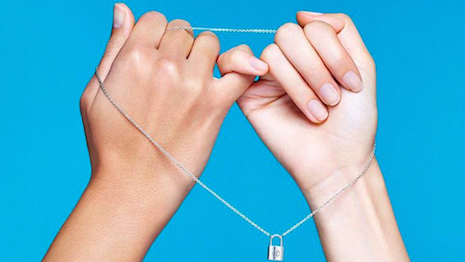
 Luxury has pinky-promised to help raise awareness and proceeds for a wide range of causes. Image credit: Louis Vuitton
Luxury has pinky-promised to help raise awareness and proceeds for a wide range of causes. Image credit: Louis Vuitton